Table of contents
Executive Summary
- Introduction
- Background and purpose
- Heritage management plan objectives
- Methodology
- Status
- Authorship
- Acknowledgements
- Language
- Previous reports
- Sources of information and images
2. Goods Island Lighthouse site
2.1 Location
2.2 Setting and landscape
2.3 Lease and management
2.4 Access
2.5 Listings
3. History
3.1 General history of lighthouses in Australia
3.2 The Commonwealth Lighthouse Service
3.3 Goods Island: a history
3.4 Building a lighthouse
3.5 Chronology of major events
3.6 Changes and conservation over time
3.7 Summary of current and former uses
3.8 Summary of past and present community associations
3.9 Unresolved questions or historical conflicts
3.10 Recommendations for further research
4. Fabric
4.1 Fabric register
4.2 Related object and associated AMSA artefact
4.3 Comparative analysis
5. Heritage significance
5.1 Commonwealth heritage listing – Goods Island Lighthouse
5.2 Condition and integrity of Commonwealth heritage values
5.3 Gain or loss of Commonwealth heritage values
5.4 Other heritage listings
6. Opportunities and constraints
6.1 Implications arising from significance
6.2 Framework: sensitivity to change
6.3 Statutory and legislative requirements
6.4 Operational requirements and occupier needs
6.5 Proposals for change
6.6 Potential pressures
6.7 Processes for decision-making
7. Conservation management principles and policies
8. Policy implementation plan
8.1 Plan and schedule
8.2 Monitoring and reporting
Appendices
Appendix 1. Glossary of heritage conservation terms
Appendix 2. Glossary of historic lighthouse terms relevant to Goods Island Lighthouse
Appendix 3. Table demonstrating compliance with the EPBC Regulations
Appendix 4. Goods Island current light details
Endnotes
Reference list
List of Figures
Figure 1. Cover photo of Goods Island Lighthouse (© AMSA, 2020)
Figure 2. Planning process applied for heritage management (Source: Australia ICOMOS, 1999)
Figure 3. Location of Goods Island Lighthouse along Australian coastline (Map Data @2021 Google,
TerraMetrics)
Figure 4. Location of Goods Island Lighthouse in the Torres Strait (Map Data @2021 Google, NASA,
TerraMetrics)
Figure 5. View of Goods Island Lighthouse (© AMSA, 2020)
Figure 6. Map of AMSA lease, Goods Island (Map data: DigitalGlobe Imagery Tile Service,
DigitalGlobe Inc. ESRI World Street Map)
Figure 7. Helicopter access at Goods Island Lighthouse site (© AMSA, 2020)
Figure 8. Incandescent oil vapour lamp by Chance Brothers (Source: AMSA)
Figure 9. Dioptric lens on display at Narooma (Source: AMSA)
Figure 10. Dalén's system - sunvalve, mixer and flasher (Source: AMSA)
Figure 11. Goode Island Tower - details, 1922. Courtesy of the National Archives of Australia. NAA:
J2776, QN 06 010 (© Commonwealth of Australia, National Archives of Australia)
Figure 12. A family group at the Goods Island Lighthouse ca. 1909 (Courtesy of the State Library of
Queensland)
Figure 13. Grassy Hill Lighthouse, Cooktown QLD, first lit 1886. Courtesy of the National Archives of
Australia. NAA: A1500, K28005 (© Commonwealth of Australia, National Archives of
Australia)
Figure 14. Goods Island Lighthouse, Goods Island (Palilag) QLD, first lit 1887 (© AMSA, 2014)
Acronym List
List of acronyms utilised throughout this heritage management plan:
Acronym | Definition |
AGA | Gas Accumulator Company |
AMSA | Australian Maritime Safety Authority |
AMSG | Australian Maritime Systems Group |
AtoN | Aid to Navigation |
BBT | Barbier, Benard, et Turenne |
CHL | Commonwealth Heritage List |
DCCEEW | Department of Climate Change, Energy, the Environment and Water |
EPBC Act | Environment Protection and Biodiversity Conservation Act 1999 (Cth) |
EPBC Regulations | Environment Protection and Biodiversity Conservation Regulations 2000 (Cth) |
HMP | Heritage Management Plan |
IALA | International Association of Marine Aids to Navigation and Lighthouse Authorities |
LED | Light emitting diode |
NAA | National Archives of Australia |
NES | National Environmental Significance |
NLA | National Library of Australia |
RMS | Record Management System |
RNE | Register for the National Estate (non-statutory archive) |
Executive summary
Built in 1886-1887, Goods Island Lighthouse was constructed to assist vessels traversing the Torres Strait. The lighthouse is notable for its heritage significance and was placed on the Commonwealth Heritage List in 2004 for its association with the maritime history of the Torres Strait. It is also notable for its rarity as being the only known lighthouse to have been constructed entirely by the Queensland State Government, and its retention of the principal characteristics of a late 19th century lighthouse.
Situated approximately 5.3 kilometres north-west of Thursday Island, the lighthouse stands on Goods Island (Palilag), a two kilometre long, uninhabited Island within the Torres Strait. The lighthouse was constructed by the Queensland State Government in 1886 and the light was first exhibited in 1887. As a working aid to navigation (AtoN), the lighthouse tower is operated and managed by the Australian Maritime Safety Authority (AMSA).
The lighthouse was fitted with an 1886 Chance Brother & Co. 250mm fixed lens on a cast iron pedestal, and the lighthouse has retained this original assembly. The light operates on an automated mechanism as part of AMSA’s network of AtoN, and equipment is serviced by AMSA’s maintenance contractor who visits at least once per year. AMSA officers visit on an ad hoc basis for auditing, project and community liaison purposes.
This heritage management plan concerns the lighthouse tower, however it also addresses the management of the surrounding precinct and land. The plan is intended to guide AMSA’s decisions and actions. AMSA has prepared this plan to integrate the heritage values of the lighthouse in accordance with the Environment Protection and Biodiversity Conservation Act 1999 Cth (EPBC Act), and the Environment Protection and Biodiversity Conservation Regulations 2000 Cth (EPBC Regulations).
Being well built and generally well maintained, the lighthouse precinct is in relatively good, stable condition. The policies and management guidelines set out in this heritage management plan strive to ensure that the Commonwealth heritage values of Goods Island Lighthouse are recognised, maintained, and preserved for future generations.

- Introduction
1.1 Background and purpose
The Australian Maritime Safety Authority (AMSA) is the Commonwealth agency responsible for coastal AtoNs. AMSA’s network includes Goods Island Lighthouse, built in 1886.
Section 341S of the Environment Protection and Biodiversity Conservation Act 1999 (Cth) (EPBC Act) requires AMSA to prepare a management plan for Goods Island Lighthouse that addresses the matters prescribed in Schedules 7A and 7B of the Environment Protection and Biodiversity Conservation Regulations 2000 (Cth) (EPBC Regulations). The principal features of this management plan are:
- a description of the place, its heritage values, their condition and the method used to assess its significance
- an administrative management framework
- a description of any proposals for change
- an array of conservation policies that protect and manage the place
- an implementation plan
- ways the policies will be monitored and how the management plan will be reviewed.
AMSA has prepared this heritage management plan to guide the future conservation of the place. This plan provides the framework and basis for the conservation and best practice management of Goods Island Lighthouse in recognition of its heritage values. The policies in this plan indicate the objectives for identification, protection, conservation and presentation of the Commonwealth heritage values of the place. Figure 2 shows the basic planning process applied. 
Figure 2. Planning process applied for heritage management (Source: Australia ICOMOS, 1999)
1.2 Heritage management plan objectives
The objectives of this heritage management plan are to:
- protect, conserve and manage the Commonwealth heritage values of Goods Island Lighthouse
- interpret and promote the Commonwealth heritage values of Goods Island Lighthouse
- manage use of the lighthouse
- use best practice standards, including ongoing technical and community input, and apply best available knowledge and expertise when considering actions likely to have a substantial impact on Commonwealth heritage values.
In undertaking these objectives, this plan aims to:
- provide for the protection and conservation of the heritage values of the place while minimising any impacts on the environment by applying the relevant environmental management requirements in a manner consistent with Commonwealth heritage management principles.
- take into account the significance of the region as a cultural landscape occupied by Aboriginal people over many thousands of years.
- recognise that the site has been occupied by lease holders since the early 20th century.
- encourage site use that is compatible with the historical fabric, infrastructure and general environment.
- record and document maintenance works, and changes to the fabric in Goods Island Lighthouse fabric register.
The organisational planning cycle and associated budgeting process is used to confirm requirements, allocate funding and manage delivery of maintenance activities. Detailed planning for the AtoN network is managed through our internal planning processes.
An interactive map showing many of AMSA’s heritage sites, including Goods Island Lighthouse, can be found at AMSA Heritage Lighthouses Interactive MapP0FP0F[i]PP.
1.3 Methodology
The methodology used in the preparation of this plan is consistent with the recommendations of The Burra Charter and with the requirements of Chapter 5, Part 15 Division 1A of the EPBC Act. In particular, the plan:
- details the history of the site based on information sourced from archival research, expert knowledge, and documentary resources,
- provides a description of the site based on information sourced from site inspection reports and fabric registers, and;
- details the Commonwealth heritage criteria satisfied by Goods Island Lighthouse as set out by schedule 7A of the EPBC Regulations.
The criterion set out at Schedule 7A (h) (i-xiii) informed the development of the required policies for the management of Goods Island Lighthouse, in conjunction with input from the Department of Climate Change, Energy, the Environment and Water (DCCEEW) on best practice management.
Consultation
In preparation of the plan, AMSA sought engagement with Kaurareg Elders who provided information on the history of the Island, and past and present associations held. This information was included within the plan.
The draft management plan was advertised in accordance with the EPBC Act and EPBC Regulations. On 4 May 2022 a notice was placed in The Australian newspaper publication which invited the general public to review the draft plan on AMSA’s website and provide feedback. Public consultation closed on 1 June 2022 and no submissions were received.
A developed draft was submitted to the Minister through the Department of Climate Change, Energy, the Environment and Water (Heritage Branch) and in that process the Minister’s delegate sought advice from the Australian Heritage Council and found the plan to be not inconsistent with the requirements of EPBC Act and EPBC Regulations.
No updates or amendments have been made in this version of the plan. Future updates and amendments will be listed here.
1.4 Status
This plan has been adopted by AMSA in accordance with Schedule 7A (Management plans for Commonwealth Heritage places) and Schedule 7B (Commonwealth Heritage management principles) of the EPBC Regulations to guide the management of the place and for inclusion in the Federal Register of Legislative Instruments.
1.5 Authorship
This plan has been prepared by AMSA. At the initial time of publication, the Australian Maritime Systems Group (AMSG) was the contract maintenance provider for the Commonwealth Government’s AtoN network including Goods Island Lighthouse.
1.6 Acknowledgements
AMSA acknowledges the professional assistance of the Kaurareg Elders in reviewing the draft plan and providing valuable information.
1.7 Language
For clarity and consistency, some words in this plan such as restoration, reconstruction and preservation, are used with the meanings defined in the Burra Charter[ii]. (See Appendix 1 Glossary of heritage conservation terms). Also see ‘Appendix 2 Glossary of lighthouse terminology relevant to Goods Island which sets out the technical terminology used in this plan.
1.8 Previous reports
- Peter Marquis-Kyle prepared a Heritage Lighthouse Report for AMSA in 2007.[iii]
- A Heritage Asset Condition Report (4th Revision) was generated by AMSG in 2020 for AMSA.[iv]
1.9 Sources of information and images
This plan has used a number of sources of information. This includes the National Archives of Australia (NAA), the National Library of Australia (NLA) and AMSA’s heritage collection.
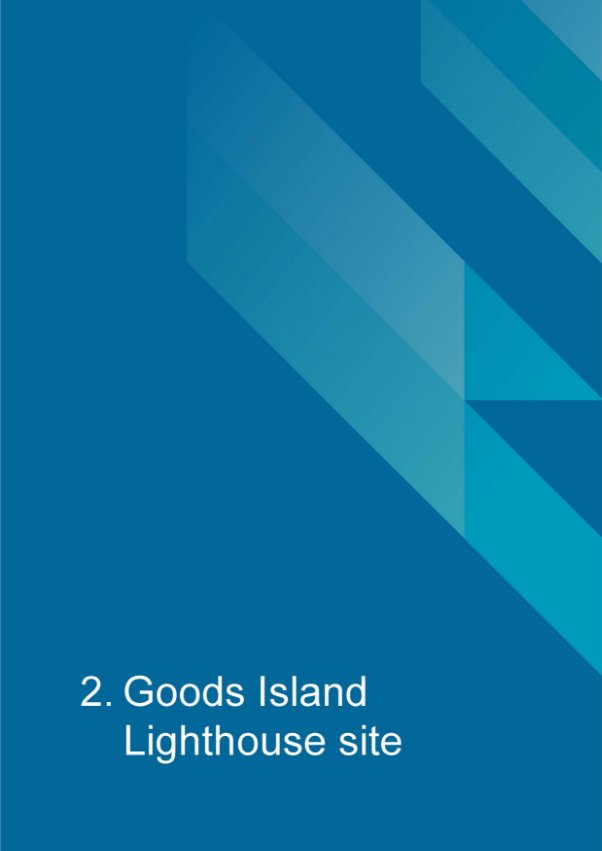
2. Goods Island Lighthouse site
2.1 Location
Goods Island marks the western entrance to the Prince of Wales Passage and the Normanby Sound in the Torres Strait, and forms part of the Thursday Island Group. The Island is approximately two kilometres in length and is uninhabited.
Goods Island Lighthouse is situated on a high point (Western Hill) on the western side of Goods Island. The island is located within the local government area of the Torres Shire Council.
Goods Island is also known by its Indigenous name, Palilag.
Lighthouse coordinates: 10° 33.9070'S, 142° 09.1290'E
Figure 3. Location of Goods Island Lighthouse along Australian coastline (Map Data @2021 Google, NASA, TerraMetrics)

Figure 4. Location of Goods Island Lighthouse in the Torres Strait (Map Data @2021 Google, NASA, TerraMetrics)
2.2 Setting and landscape
Goods Island is considered part of the Inner/Western Torres Strait island group, and these islands were formed on acidic volcanic and plutonic basement. The terrain of the island is rocky with steep hills. The lighthouse is located adjacent to and on top of a rocky outcrop and the land drops away on all sides, limiting development around the lighthouse and within its main path of light to the Arafura Sea.
The topography of the island is such that the lighthouse is a visually prominent feature within the broader landscape.
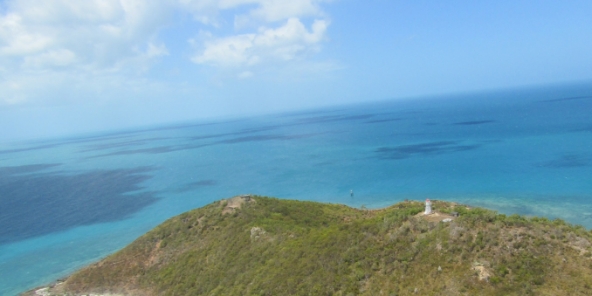
Figure 5. View of Goods Island Lighthouse (© AMSA, 2020)
Fauna and flora
Goods Island shares similar ecosystems with the larger islands of Prince of Wales (Muralug) and Horn (Ngurapai). These islands generally support bush and scrub flora on well-drained slopes. Goods Island’s rocky hills are characteristic of this, and the island’s surface is covered with low-lying vegetation. The invasive floral species, Snake Weed (Stachytarpheta jamaicensis), has previously been recorded on the island.[v]
2.3 Lease and management
AMSA leases the lighthouse from the Department of Natural Resources, Mines, and Energy (QLD), the state body responsible for Goods Island. The AMSA lease, signed on 1 July 2000, consists of two parcels of land:
- Lot 2 CP890154: 528 metres-squared
- Lot 3 CP890154: 52 meters-squared
The only structures within this leased-area are:
- Goods Island Lighthouse
- Helipad
Additional on-site buildings outside of AMSA’s lease include:
- 2 x ancillary buildings (currently unused)

Figure 6. Map of AMSA lease, Goods Island (Map data: DigitalGlobe Imagery Tile Service, DigitalGlobe Inc. ESRI World Street Map)
2.4 Access
Goods Island Lighthouse can be accessed via helicopter or vessel. A helipad is located beside the tower, and a path leads through the vegetation to a vessel landing area. Access inside the lighthouse is restricted to authorised personnel only.
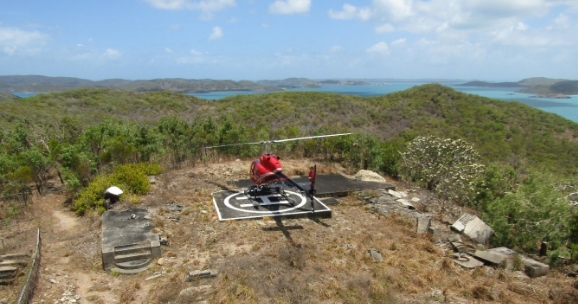
Figure 7. Helicopter access at Goods Island Lighthouse site (© AMSA, 2020)
2.5 Listings
Goods Island Lighthouse is listed on the following heritage registers:
List | ID |
Commonwealth Heritage List | 105458[vi] |
Register of the National Estate | 101518[vii] |

3. History
3.1 General history of lighthouses in Australia
The first lighthouse to be constructed on Australian soil was Macquarie Lighthouse, located at the entrance to Port Jackson, NSW. First lit in 1818, the cost of the lighthouse was recovered through the introduction of a levy on shipping. This was instigated by Governor Lachlan Macquarie, who ordered and named the light.
The following century oversaw the construction of hundreds of lighthouses around the country. Constructing and maintaining a lighthouse were costly ventures that often required the financial support of multiple colonies. However, they were deemed necessary aids in assisting the safety of mariners at sea. Lighthouses were firstly managed by the colony they lay within, with each colony developing their own style of lighthouse and operational system. Following Federation in 1901, which saw the various colonies unite under one Commonwealth government, lighthouse management was transferred from state hands to the Commonwealth Lighthouse Service.
Lamps and optics: an overview
Lighthouse technology has altered drastically over the centuries. Eighteenth century lighthouses were lit using parabolic mirrors and oil lamps. Documentation of early examples of parabolic mirrors in the United Kingdom, circa 1760, were documented as consisting of wood and lined with pieces of looking glass or plates of tin. As described by Searle, “When light hits a shiny surface, it is reflected at an angle equal to that at which it hit. When a light source is placed in the focal point of a parabolic reflector, the light rays are reflected parallel to one another, producing a concentrated beam”.[viii]
In 1822, Augustin Fresnel invented the dioptric glass lens. By crafting concentric annular rings with a convex lens, Fresnel had discovered a method of reducing the amount of light absorbed by a lens. The Dioptric System was adopted quickly with Cordouran Lighthouse (France), which was fitted with the first dioptric lens in 1823. The majority of heritage-listed lighthouses in Australia house dioptric lenses made by others such as Chance Brothers (United Kingdom), Henry-LePaute (France), Barbier, Bernard & Turenne (BBT, France) and Svenska Aktiebolaget Gasaccumulator (AGA of Sweden). These lenses were made in a range of standard sizes, called orders—see ‘Appendix 2. Glossary of lighthouse Terms relevant to Goods Island Lighthouse’.
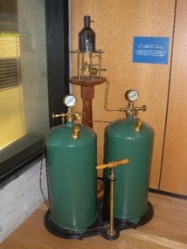

Figure 8. Incandescent oil vapour lamp by Chance Brothers (Source: AMSA)
Figure 9. Dioptric lens on display at Narooma (Source: AMSA)
Early Australian lighthouses were originally fuelled by whale oil and burned in Argand lamps, and multiple wicks were required in order to create a large flame that could be observed from sea. By the 1850s, whale oil had been replaced by colza oil, which was in turn replaced by kerosene, a mineral oil.
In 1900, incandescent burners were introduced. This saw the burning of fuel inside an incandescent mantle which produced a brighter light with less fuel within a smaller volume. Light keepers were required to maintain pressure to the burner by manually pumping a handle as can be seen in Figure 8.

Figure 10. Dalén's system - sunvalve, mixer and flasher (Source: AMSA)
In 1912, Swedish engineer Gustaf Dalén, was awarded the Nobel Prize in physics for a series of inventions relating to acetylene-powered navigation lights. Dalén’s system included the sun valve, the mixer, the flasher, and the cylinder containing compressed acetylene. Due to their efficiency and reliability, Dalén’s inventions led to the gradual de-staffing of lighthouses. Acetylene was quickly adopted by the Commonwealth Lighthouse Service from 1915 onwards.
Large dioptric lenses, such as that shown in Figure 9, gradually decreased in popularity due to cost and the move towards unmanned automatic lighthouses. By the early 1900s, Australia had stopped ordering these lenses with the last installed at Eclipse Island in Western Australia in 1927. Smaller Fresnel lenses continued to be produced and installed until the 1970s when plastic lanterns, still utilising Fresnel’s technology, were favoured instead. Acetylene remained in use until it was finally phased out in the 1990s.
In the current day, Australian lighthouses are lit and extinguished automatically using mains power, diesel generators, and solar-voltaic systems.
3.2 The Commonwealth Lighthouse Service
When the Australian colonies federated in 1901, they decided that the new Commonwealth government would be responsible for coastal lighthouses—that is, major lights used by vessels travelling from port to port—but not the minor lights used for navigation within harbours and rivers. There was a delay before this new arrangement came into effect. Existing lights continued to be operated by the states.
Since 1915, various Commonwealth departments have managed lighthouses. AMSA, established under the Australian Maritime Safety Authority Act 1990 (Cth), is now responsible for operating Commonwealth lighthouses and other aids to navigation, along with its other functions.
3.3 Goods Island: a history
Aboriginal history
Goods Island is in the Kaiwalagal region (Endeavour Strait) and is known by Kaurareg people traditionally as Palilag, and the island is referred to in the Waubin Dreaming Story. Waubin of Muralag (Prince of Wales Island), was feared by men and known to wield kubai (a throwing stick known as a woomera), a kalak (a spear) and baidamal baba. Waubin would collect wives for every man he killed, and he lived with them at his home, Rabau Nguki. Eventually Waubin had to leave Rabau Nguki with his wives, and he led them to Badhaukuth on the western side of Muralag, then to Gialag (Friday Island), before reaching Palilag. Although Waubin continued on to Nomi (Round Island), Koimilai (a point on Kiriri), he left some of his wives at Palilag and they all turned to stone. As for Waubin, he stepped into the sea near Gobau Ngur, a rocky headland of Kiriri, and turned to stone.[ix]
Although there was no long-term inhabitation of the Palilag, it is understood the island was regularly visited and used as fishing grounds both before, during and after European settlement. At least two fish traps have been recorded on Palilag, one being the Bertie Bay fish trap.[x] Pearling began in the Torres Strait in 1868, and by 1877, 16 pearling firms were operating on Thursday Island. Palilag was one of the key bases for the Torres Strait pearling industry, and the activity became cemented in the culture of the region. Following the establishment of the lightstation, visits to the island continued.
Early European history
The Torres Strait was named after the Spanish captain, Luis Vaz de Torres, who sailed through the Straits in 1606 on his way to the Philippines. Individual islands retained their traditional names, but also acquired European names in the years following de Torres’s exploration. Prominent European explorers such as the navigator Captain James Cook, Vice-Admiral William Bligh and the navigator Captain Matthew Flinders sailed through the Straits in the late eighteenth and early-nineteenth centuries.
Goods Island was given its European name by Flinders after Peter Good, the botanical gardener on board his vessel the Investigator during the 1802 voyage. Over time, the name ‘Goods’ was misspelt as ‘Goode’ and the island is referred to as such in literature throughout the nineteenth and early-twentieth centuries.
In Flinders’ account of Goods Island, he wrote:
“In the morning of Nov. 2, the wind being more moderate and at E. S. E., we steered between Hammond's Island and the north-western reef, with soundings from 6 to 9 fathoms. Another island appeared beyond Hammond's, to the south- west, which, as it had no name, I called Good's Island, after Mr. Good, the botanical gardener; and we hauled up for it, passing a rock and a small reef between the two. On seeing an extensive shoal ahead, which would have carried us off the land to go round it, we anchored in 7 fathoms, dead coral and shells, with the north end of Hammond's Island bearing N. 64° E., four or five miles. The botanical gentlemen landed on Good's Island; and in the afternoon I took these bearings amongst others, from a hill near its south-west end. The ship, distant 1¼ miles N. 58° 0' W. Wallis' Isles, over the Shoal Cape of Bligh, S. 23 5 W. Booby Isle, centre, S. 80 0 W. Northern isles, the westernmost visible, N. 28° 10' to 24 5 W. Hawkesbury Island, N. 9 15 to 4 0 W. North-west reef, its apparent termination, N. 38 50 W.”[xi] |
Vessels regularly passed through the Torres Strait in the first half of the nineteenth century, increasingly so after Philip Parker King recommended traversing the inner route in 1833.[xii] In 1834, the British East India Company’s trading monopoly was broken and Sydney-based traders took more interest in the western Pacific as they were able to supply the Chinese market with goods such as beche-de-mer and sandalwood. The strategic importance of shipping routes to Queensland’s north stimulated the establishment of the Somerset settlement on the eastern coast of Cape York, just south of the tip, looking over Albany Passage to Albany Island. Queensland had hopes that Somerset would become a ‘second Singapore’.[xiii]
In 1872, Queensland annexed the islands up to 60 miles from Cape York. The Somerset settlement was moved to Thursday Island in 1875-77 and in 1879, the remaining islands were annexed and the Torres Strait islands became part of Queensland.[xiv]
3.4 Building a lighthouse
Why Goods Island?
The reefs and shoals of the Great Barrier Reef, at the southern end of the inner route, and in the Torres Strait, were notoriously dangerous for shipping. Ipili Reef, close to Goods Island, claimed several ships, including the paddle steamer Phoenix (1855).[xv] There were 64 wrecks on the inner route between 1840 and 1850.[xvi] The importance of trade with India and China, as well as the developing pearling industry, put pressure on the Queensland government to install navigational aids in the Torres Strait.
On 14 July 1882, the Torres Strait pearling industry wrote to the Colonial Secretary requesting a light at the western end of the Torres Strait. Pearling began in the Torres Strait in 1868 with 16 pearling firms operating on Thursday Island in 1877 and Goods Island was one of the key bases for the Torres Strait pearling industry. The request was referred to the Colonial Treasurer as minister responsible for ports and harbours and then to the port master, G.P. Heath for a report. Heath agreed that a light was essential.[xvii]
Booby Island to the west of Goods Island had previously been suggested as a potential lighthouse site at the 1873 Inter-colonial Conference, however no action had been taken. Heath had already established a number of navigational aids on the Queensland coast, initially harbour lights and beacons, and added lighthouses when new ports opened in the more treacherous waters on the North Queensland coast.
A signal station had previously been established on Goods Island c. 1877, and it was determined by Heath that the signalman already stationed on the island could also operate a lighthouse. Heath wrote in his annual report: “In Torres Straits a good position light is required at Goode Island to point out the position of the entrance to Normanby Sound and the Prince of Wales Channel. This light could be attended to by the signalman stationed on the island”.[xviii]
However, fiscal restraint exercised by the 1879 McIlwraith Government delayed the initial construction of the lighthouse.
Heath’s Notice to Mariners (No. 27 of 1882) dated 13th October 1882 stated:
‘On and after this date, a Temporary Light will be exhibited from the [first] Signalman’s Cottage on Goode Island at an elevation of 250 feet above the sea level. The Light will be visible from a distance of 7 or 8 miles when clear of the North end of Hammond Island and North about, until it bears E.N.E and also in Normanby Sound between N by E and N.W by N.’[xix] |
When exhibited, the light was described in Pugh’s Almanac:
‘A bright light is shown from sunset to sunrise from the veranda of the signalman’s cottage on Goode Island. It is about 250 feet above sea level and is visible over an area from N.E by E round by North to W.S.W, to a distance of 8 or 9 miles in fine weather.’[xx] |
Heath visited the Torres Strait, including Goods Island, in 1886 and selected the site for the lighthouse on the highest point, Western Hill, near Tucker Point, at 327 feet (99.7 metres) above sea level.[xxi] Heath noted in his report of this trip to the Torres Strait that the increase in ship traffic through the straits, particularly from Cooktown, was most likely due to the discovery of gold on the Palmer River in 1873 and migration to the goldfields.[xxii]
Design and construction
No requests for tenders were issued for the construction of the lighthouse, indicating that the lighthouse was likely constructed by the Queensland Government as opposed to hiring private contractors. It is believed that Goods Island Lighthouse was the only lighthouse of this type to be built entirely by the Queensland Government during the late-nineteenth century.[xxiii]
An order was made for a light destined for Goods Island, and this was captured in correspondence to the Queensland treasurer in 1886:
‘For Goode Island, one fixed 4th order apparatus, to illuminate an arc of 180°, & to be fitted with totally reflecting glass mirrors. The lamp to be fitted with three burners & spare reservoir & tubing. The burners to be fitted with 2 wicks, & without the central dispersers, to be fitted with Farquhars chimneys, & the level of the oil to stand at a distance of two inches below the top of the burner. The apparatus to be adjusted to an elevation of 250 feet [sic].’[xxiv] |
It is difficult to fix an exact construction date of the Goods Island lighthouse. G P Heath’s Torres Strait sailing directions, published in the 1885 Pugh’s Almanac, stated that the “temporary light would be replaced in the ensuing year”.[xxv]
In December 1886, a notice appeared in the Queensland Telegraph newspaper stating: “Goode Island Lighthouse- This lighthouse which has been constructed in sections in Brisbane, will be forwarded to its destination by the next steamer leaving for Thursday Island. It will, when erected on Goode Island be a vast improvement on the present light which marks the entrance into the harbour at Thursday Island.”[xxvi]
This was followed in 1887 by the publication of a ‘Notice to Mariners’ stating:
“Goode Island- Exhibition of Permanent Light; Discontinuation of Temporary Light….The Queensland Government has given further notice, that on 22nd March, 1887, the permanent light will be exhibited from a lighthouse erected on the western hill (327 feet) of Goode Island, near Tucker Point, and that the temporary light would then be discontinued…..The signal station, heretofore situated on a hill near the centre of Goode Island, has been transferred to the western hill.”[xxvii] |
It is, therefore, probable that the lighthouse was erected between about December 1886 and March 1887.
Equipment when built
Upon completion, Goods Island Lighthouse stood as a timber framed, corrugated iron-clad structure. Apart from its heavy cross-bracing, the tower was otherwise similar to the previous iron-plated design for lighthouses in Australia built at that time. The sheeting was specially formed with tapering corrugations to suit the conical shape of the tower.[xxviii] As Goods Island was elevated in parts, there was no need for the lighthouse to be particularly tall. The tower was just below 5 metres high and located 105 metres above sea level.
The tower was fitted with the specified 4th Order Chance Brothers dioptric with a fixed light, a flasher, and a ‘totally reflecting’ glass mirror.[xxix] The light covered more than 180 degrees. The light was described as being visible between the bearings of north east by east through south and south west and would be visible in fine weather for 24 miles.[xxx] Goods Island was the fourth lighthouse of a total of only nine of this type to be constructed in Queensland.[xxxi]
 Figure 11. Goode Island Tower - details, 1922. Courtesy of the National Archives of Australia. NAA: J2776, QN 06 010 (© Commonwealth of Australia, National Archives of Australia)[xxxii]
Figure 11. Goode Island Tower - details, 1922. Courtesy of the National Archives of Australia. NAA: J2776, QN 06 010 (© Commonwealth of Australia, National Archives of Australia)[xxxii]
Light keeping
Goods Island Lighthouse was overseen by a number of keepers when it was first lit in 1887. By the turn of the twentieth century, Goods Island, which by now included a lightstation, signal station, pilot station and pearl-shelling base, had become home to various families. In 1902, a school was established on the southern shore of the island and by 1904, fourteen children were enrolled.[xxxiii] Gradually however, inhabitants on Goods Island dwindled, and by 1912 it was reported that only two families remained on the island.[xxxiv]
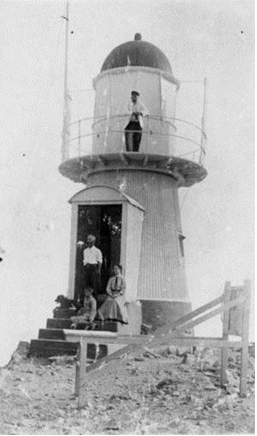
Figure 12. A family group at the Goods Island Lighthouse ca. 1909 (Courtesy of the State Library of Queensland)[xxxv]
The lighthouse launch Roonganah travelled twice a month from Thursday Island bringing mail and stores for the keepers stationed at the island. Landing points were either at the pilot station jetty on the southeast shore or at the foot of the tramway at half tide or above.
Throughout the duration of the Second World War, the keepers were removed from the lightstation, and operation of the light was overseen by the military as naval surveillance was carried out in the waters of the Torres Strait. This arrangement only lasted for the duration of the war and keepers were reinstated in the early 1950s.
Alongside tending to the light, keepers were required to report maintenance on the lighthouse and accompanying residence – reports that shed light on the condition of the lightstation over time. In 1957, the keepers reported on ‘repairing washaway on trolley line’, ‘painting cream inside engine shed’, ‘painting radio mast and outside engine shed’, ‘painting outside of outhouses’, ‘painting water tanks’. In 1958 it was revealed that a new water tank was constructed at the station, and in 1959, loose paint was scraped from inside the lantern room.[xxxvi]
The rainfall station closed on 20 November 1973 when the last lighthouse keeper, Townsend, departed.
Second World War
Goods Island and its lightstation were changed dramatically following the onset of World War II (1939-1945). The need to fortify Goods Island had been previously analysed as early as 1907, and a 1913 contour survey of the island clearly demonstrated that Tucker Point, Quoin Point and Tessy Head at the western and eastern extremes of the island were slated for defence purposes.[xxxvii] However, it was not until World War II that Goods Island was fully utilised for defence strategies along the northern coastline of Australia.
The Department of the Interior constructed emplacements and other defence works on Goods Island, commencing in October 1940. By July 1941, guns had been assembled and proof-fired, and by December a three storied command post and searchlight engine rooms were constructed with equipment and stores positioned. Five foot fortress searchlights installed at both Milman Hill (on Thursday Island) and Goods Island batteries were utilised to illuminate areas of water, through which attacking vessels had to pass in order to reach the main land of Australia.
In 1942 Navy personnel requested permission to manage the lights on Goods Island under the supervision of Senior Mechanic Kerlin. Lighthouse keeper Everett was withdrawn on 12 November 1942, allowing personnel exclusive use of the keeper’s cottage and station. It was agreed the arrangement was only to be for the duration of the war.[xxxviii]
During this period, the Australian defence forces erected numerous buildings and structures along the western side of Goods Island, remnants of which remain within close proximity to the lighthouse today. Evidence of this period of the island’s history can be seen in the observation building and radar screen, the generator shed as well as inscriptions made in concrete near the flagstaff. It is assumed that concrete retaining walls were also constructed around the lighthouse around the same time of the observation building’s construction.
The Navy remained at Goods Island until the early 1950s when the last vestiges of military installations were abandoned. Some of these constructions were removed in 1953 and the radar screen was declared obsolete.
3.5 Chronology of major events
The following table details the major events to have occurred at Goods Island Lighthouse.
Date | Event |
1902 | School established on Goods Island for the keepers’ children. |
1907 | Earthquake strikes Goods Island, lighthouse reported as damaged.[xxxix] |
3 June 1927 | Lighthouse Keeper Valentine Cecil Cloherty passes away due to heart strain believed to be from carrying stores to Goods Island Lighthouse during a period where the tramway was broken down. Commonwealth Government later instructed to pay compensation to Cloherty’s widow.[xl] |
11 January 1936 | Lighthouse and signal station struck by lightning. Telephone, flagstaff and walls of engine shed damaged.[xli] |
1939 | The Hydrographic Admiralty corrected the name ‘Goode Island’ to Goods Island.[xlii] |
1940 | Department of the Interior construct emplacements on Goods Island in response to the outbreak of World War II. |
July 1941 | Guns assembled on Goods Island. |
December 1941 | A command post and searchlight engine room established on Goods Island. |
1942 | The Australian Navy take over full operation of the lighthouse, Lighthouse Keeper Everett withdrawn 12 November. |
c. 1950s | Navy relinquish control of lighthouse and withdraw from the island. |
1953 | Some of the structures built for the war removed. |
1957 | Submarine cable laid at Goods Island allowing telephonic connection from the lighthouse to Thursday Island.[xliii] |
1973 | Lighthouse destaffed. |
3.6 Changes and conservation over time
The following section details the changes and conservation efforts to have been carried out at Goods Island Lighthouse since its construction.
The Brewis Report
Commander CRW Brewis, retired naval surveyor, was commissioned in 1911 by the Commonwealth Government to report on the condition of existing lights and to recommend any additional ones. Brewis visited every lighthouse in Australia between June and December 1912, and produced a series of reports published in their final form in March 1913. These reports were the basis for future decisions made in relation to the individual lighthouses and provide a snapshot of the lightstation in the early 20th century.
Brewis recommended that Goods Island be given a distinctive character, have the light’s intensity increased, and that an assistant keeper be employed.[xliv]
Goode Island Light. (15 miles from Booby Island.) Lat. 10° 34’ S., Long. 142° 09’ E., Chart No. 691. This light was established in the year 1882, and last altered in 1887. An important signal station, connected by telephone with Thursday Island. Character. – One white, fixed, dioptric, 4th order. Illuminant, kerosene. Candlepower, under 1,000. Condition, &c. – The light-house tower and apparatus are in good order. A new roof is required to the light-keeper’s dwelling, the verandah needs repair, new tanks should be provided, and the tramway requires renewals. There is only one light-keeper at te station, so the present light though attended, is unwatched. – An assistant light-keeper is necessary, as the signal duties are occasionally very strenuous. RECOMMENDED. – (a) The light be given a distinctive character by inserting a revolving cylinder, actuated by clockwork mechanism (to be wound every fifteen hours), thus converting the light from fixed to flashing. Light characteristic, one flash of one-third second duration every three seconds. (b) The power of the light be increased from under 1,000 c.p. to 5,000 c.p., by installing a 35 mm. incandescent mantle. Illuminant, vaporized kerosene. Visible, 24 nautical miles. (c) An assistant light-keeper be provided. |
Alteration to the light
The following table details the changes to the Goods Island light since its exhibition in 1887.
Date | Alteration |
7 February 1937 | Light converted to automatic operation, acetylene light source installed. |
1957 | 5 horsepower Kelly and Lewis engine replaced with 5 horsepower diesel engine. |
c.1970s | Flagstaff removed |
1988 | Light converted to solar powered operation, halogen light source fitted within lantern. |
For information on current light details, see ‘Appendix 4 Goods Island Lighthouse current light details’.
Recent conservation works
The following table details the recent conservation works to have occurred at Goods Island Lighthouse.
Date | Work |
1955 | Balcony balustrades repaired and reinstalled. |
November 2013 | Lantern dome patch holes repaired. |
2021 | Major refurbishment works including: - Corrosion reparations to lantern room and balcony
- Timber reparations to structure frame
- Replacement of corrugated cladding (walls and entrance porch)
- Corrosion repairs to base ring
- Repainting of lighthouse (internal and external)
|
3.7 Summary of current and former uses
From its construction in 1886, Goods Island Lighthouse has been used as a marine AtoN for mariners at sea. Its AtoN capability remains its primary use. The quarters, once used to house keepers stationed at the tower, are no longer on site.
The lighthouse, and the island as a whole, were also utilised for naval efforts throughout the duration of World War II. By the early 1940s, various structures built for the purpose of surveilling surrounding waters had altered the original layout of the lightstation. Keepers were removed from the island, and the cottages were for the full use of military personnel. The lighthouse retained its original purpose as an AtoN and was operated by those stationed on Goods Island.
3.8 Summary of past and present community associations
Kaurareg past and present associations
Kaurareg are the traditional owners and knowledge-holders for the region. Kaurareg and the wider Torres Strait community maintain strong connections to Palilag. Today, the island is often visited by traditional custodians for fishing, hunting, camping and other reasons.
Local, national and international associations
The lighthouse maintains strong familial links due to its extensive history as a staffed site. Numerous families were stationed at Goods Island, and their experiences were captured by contemporary sources.
The lighthouse and larger landscape of the island also maintain strong association with the Australian war effort following the outbreak of the Second World War. The military personnel stationed on the island were responsible for tending to the light, and remnants found at site shed light on naval surveillance during this period.
Impacts to community involvement
Management, and changes in management, of Goods Island Lighthouse have the potential to impact community groups with interests in the lighthouse and site. Management change may impact site access arrangements, third-party licence agreements, the provision of historical records, or the continued operation of the lighthouse as an aid to navigation.
In the event management changes with the potential to impact community stakeholders are proposed, stakeholders will be notified and consulted.
3.9 Unresolved questions or historical conflicts
It is uncertain when designs of Goods Island Lighthouse were originally drawn, and when construction of the tower commenced. It is understood that work was underway by 1886, however there is no clear idea of when workers were first mobilised to site.
3.10 Recommendations for further research
Further investigation on the design and construction process would be beneficial in understanding the significance of Goods Island as the only lighthouse of its type to have been constructed by the Queensland Government. Clarification on why a Government-constructed process was chosen, as opposed to hiring a private contractor, would assist these understandings.
Further research on the keepers and military personnel stationed at Goods Island would be beneficial in understanding the social history of the lightstation and island as a whole throughout the late-19th to mid-20th centuries.

4. Fabric
4.1 Fabric register
The cultural significance of the lighthouse resides in its fabric, and also in its intangible aspects, such as the meanings people ascribe to it, and the connections to other places and time periods. The survival of its cultural value depends on a well-informed understanding of what is significant, and on clear thinking about the consequences of change. The Burra Charter sets out good practice for conserving cultural significance.
Below, each part of the lighthouse is listed and the description, condition and significance of each part is discussed. Criterion listed under ‘Heritage Significance’ refer to the criterion satisfied within the specific Commonwealth heritage listing (see ‘Section 5.1’).
(All images in sub-sections 4.1 and 4.2 – Source: AMSA)
Lighthouse feature: Lantern roof

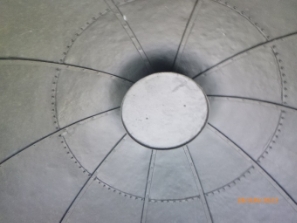 © AMSA, 2022
© AMSA, 2022
Description and condition
1886 Queensland Government design part-spherical dome with single skin of galvanised sheets lapped and screwed. Underwent extensive patch repairs 2021.
- Ribs – iron radial ribs
- Inner skin – none
- Ventilator – mushroom type
- Lightning conductor – vertical pole beside ventilator, with three spikes at top, and two braces to ventilator
- Gutter – circular ring of cast iron pieces bolted together
- Drip tray – copper dish suspended under ventilator
Finish | painted |
Condition | intact and sound |
Integrity | medium |
Significance | high |
Maintenance | keep in service, prepare and repaint at normal intervals |
Rectification works | none |
Heritage significance:
The lantern roof is an original part of a lighthouse associated with the maritime history of the Torres Strait (criterion a).
The lantern roof is an original part of a lighthouse constructed entirely by government labour (criterion b).
The lantern roof is an original part of a lighthouse that demonstrates the principal characteristics of a late 19th century Queensland lighthouse (criterion d).
Lighthouse feature: Lantern glazing

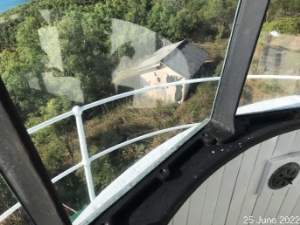 © AMSA, 2022
© AMSA, 2022
Description and condition
1886 Qld Government design.
- Panes – flat trapezoidal glass, one tier toughened safety glass
- Astragals – T section cast copper alloy, bolted to gutter ring at top, and to lantern base below
- Downpipes – removed, rainwater discharges through short vertical spitters attached to gutter
Finish | astragals and glazing strips: painted |
Condition | intact and sound |
Integrity | medium |
Significance | high |
Maintenance | keep in service, reglaze as necessary, prepare and repaint at normal intervals |
Rectification works | none |
Heritage significance: High
The lantern glazing is an original part of a lighthouse associated with the maritime history of the Torres Strait (criterion a).
The lantern glazing is an original part of a lighthouse constructed entirely by government labour (criterion b).
The lantern glazing is an original part of a lighthouse that demonstrates the principal characteristics of a late 19th century Queensland lighthouse (criterion d).
Lighthouse feature: Lantern base
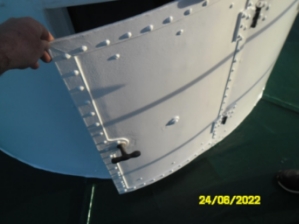
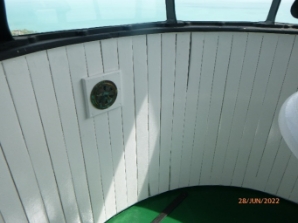 © AMSA, 2022
© AMSA, 2022
Description and condition
1886 cylindrical in form.
- Frame – timber
- Internal lining – timber beaded tongue-and-groove vertical boards, V jointed
- External sheeting – riveted galvanised iron plates
- Vents – small cast metal cowls near the bottom of the lantern base exterior; small round copper alloy regulators near the top of the lantern base interior
- Door – Curved iron plate door with flat frame riveted around its perimeter. Copper alloy surface mounted hinges. Copper alloy handles inside and out. Secured by stainless steel compression type door latch.
Finish | painted |
Condition | intact and sound |
Integrity | high |
Significance | high |
Maintenance | keep in service, prepare and repaint at normal intervals, monitor door seal |
Rectification works | none |
Heritage significance: High
The lantern base is an original part of a lighthouse associated with the maritime history of the Torres Strait (criterion a).
The lantern base is an original part of a lighthouse constructed entirely by government labour (criterion b).
The lantern base is an original part of a lighthouse that demonstrates the principal characteristics of a late 19th century Queensland lighthouse (criterion d).
Lighthouse feature: Lantern floor
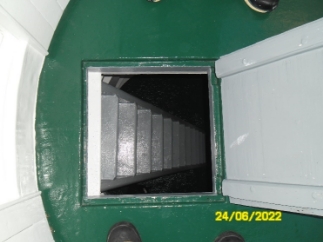 © AMSA, 2022
© AMSA, 2022
Description and condition
1886 timber floor, with hardwood joists in radial arrangement. Timber floor boards with sheet lead covering (new lead sheet installed 2021). Square access hole with timber trapdoor.
Finish | painted |
Condition | intact and sound |
Integrity | high |
Significance | high |
Maintenance | keep in service, prepare and repaint at normal intervals |
Rectification works | none |
Heritage significance: High
The lantern floor is an original part of a lighthouse associated with the maritime history of the Torres Strait (criterion a).
The lantern floor is an original part of a lighthouse constructed entirely by government labour (criterion b).
The lantern floor is an original part of a lighthouse that demonstrates the principal characteristics of a late 19th century Queensland lighthouse (criterion d).
Lighthouse feature: Lens assembly
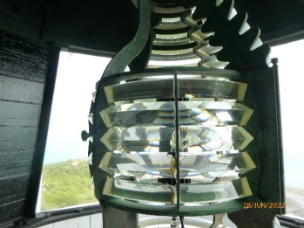 © AMSA, 2022
© AMSA, 2022
Description and condition
1886 Chance Brothers 250mm focal radius fixed (not-rotating) lens assembly of glass and gunmetal. Panel of reflecting prisms opens for access.
Condition | intact and sound |
Integrity | high |
Significance | high |
Maintenance | keep in service, clean optic at normal intervals |
Rectification works | none |
Heritage significance: High
The lens assembly is an original part of a lighthouse associated with the maritime history of the Torres Strait (criterion a).
The lens assembly is an original part of a lighthouse constructed entirely by government labour (criterion b).
The lens assembly is an original part of a lighthouse that demonstrates the principal characteristics of a late 19th century Queensland lighthouse (criterion d).
Lighthouse feature: Light source
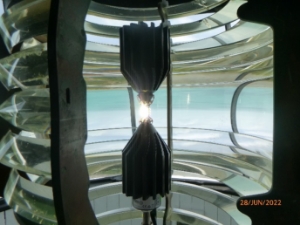 © AMSA, 2022
© AMSA, 2022
Description and condition
Sealite LED beacon.
Condition | intact and sound |
Integrity | high |
Significance | low |
Maintenance | keep in service |
Rectification works | none |
Heritage significance: Low
Lighthouse feature: Pedestal

 © AMSA, 2022
© AMSA, 2022
Description and condition
1886 cast iron pedestal and top.
Finish | painted |
Condition | intact and sound |
Integrity | high |
Significance | high |
Maintenance | keep in service, prepare and repaint pedestal at normal intervals |
Rectification works | none |
Heritage significance: High
The pedestal is an original part of a lighthouse associated with the maritime history of the Torres Strait (criterion a).
The pedestal is an original part of a lighthouse constructed entirely by government labour (criterion b).
The pedestal is an original part of a lighthouse that demonstrates the principal characteristics of a late 19th century Queensland lighthouse (criterion d).
Lighthouse feature: Balcony floor

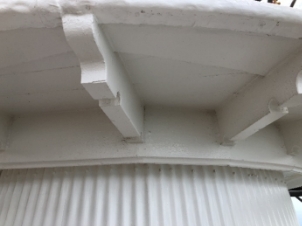
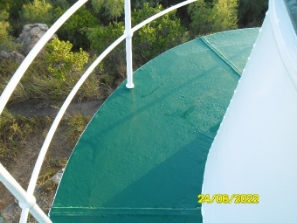 © AMSA, 2022
© AMSA, 2022
Description and condition
Finish | painted |
Condition | intact and sound |
Integrity | high |
Significance | high |
Maintenance | keep in service, prepare and repaint at normal intervals, monitor condition of lead sheeting |
Rectification works | none |
(Continuation of lantern floor) 1886 timber floor. Hardwood joists in radial arrangement. Hardwood tongue and groove floorboards. Covered with sheet lead (installed 2021), with folded lap joints.
Heritage significance: High
The balcony floor is an original part of a lighthouse associated with the maritime history of the Torres Strait (criterion a).
The balcony floor is an original part of a lighthouse constructed entirely by government labour (criterion b).
The balcony floor is an original part of a lighthouse that demonstrates the principal characteristics of a late 19th century Queensland lighthouse (criterion d).
Lighthouse feature: Balcony balustrade
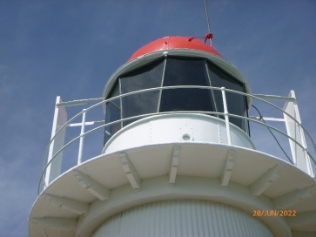 © AMSA, 2022
© AMSA, 2022
Description and condition
316 Stainless steel tube with solid wrought iron stanchions bolted to balcony floor, with wrought eyes. Round stanchion bases bolted to balcony floor. Satellite transponder fixed to top rail.
Finish | painted |
Condition | intact and sound |
Integrity | high |
Significance | high |
Maintenance | keep in service, prepare and repaint at normal intervals |
Rectification works | none |
Heritage significance: High
The balcony balustrades are an early part of a lighthouse associated with the maritime history of the Torres Strait (criterion a).
The balcony balustrades are an early part of a lighthouse constructed entirely by government labour (criterion b).
The balcony balustrades are an early part of a lighthouse that demonstrates the principal characteristics of a late 19th century Queensland lighthouse (criterion d).
Lighthouse feature: Light screens

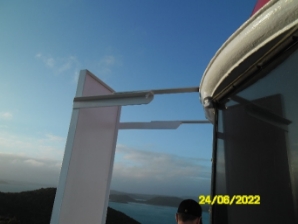 © AMSA, 2022
© AMSA, 2022
Description and condition
Recent plywood screens attached to the balcony balustrade and supported by steel brackets attached to lantern gutter. These are in a similar configuration to an earlier pair of screens made of solid timber.
Finish | painted |
Condition | intact and sound |
Integrity | medium |
Significance | moderate |
Maintenance | keep in service, prepare and repaint at normal intervals |
Rectification works | none |
Heritage significance: moderate
The light screens are a replica of an early part of a lighthouse associated with the maritime history of the Torres Strait (criterion a).
The light screens are a replica of an early part of a lighthouse constructed entirely by government labour (criterion b).
The light screens are a replica of an early part of a lighthouse that demonstrates the principal characteristics of a late 19th century Queensland lighthouse (criterion d).
Lighthouse feature: Walls

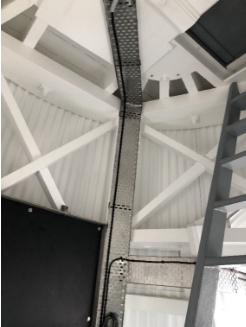
© AMSA, 2022
Description and condition
1886 timber frame with recent corrugated 316 stainless steel cladding.
- Sheeting – the tower is covered with 316 stainless steel cladding, with corrugations tapered to suit conical form of the tower
- Frame – hardwood studs and rails joined with housing joints to horizontal plates and girts – connections are reinforced with forged iron straps bolted to timber members. New patch pieces of Queensland hardwood installed 2021.
- Base plate – cast iron ring made in sections bolted together, incorporating vertical tags to which the studs are bolted
Finish | painted inside and out |
Condition | intact and sound |
Integrity | medium |
Significance | high |
Maintenance | keep in service, prepare and repaint at normal intervals, monitor condition of external cladding |
Rectification works | none |
Heritage significance: High
The walls are an original part of a lighthouse associated with the maritime history of the Torres Strait (criterion a).
The walls are an original part of a lighthouse constructed entirely by government labour (criterion b).
The walls are an original part of a lighthouse that demonstrates the principal characteristics of a late 19th century Queensland lighthouse (criterion d).
Lighthouse feature: Windows

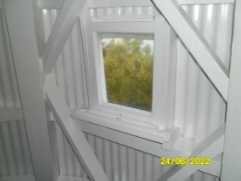 © AMSA, 2022
© AMSA, 2022
Description and condition
Two 1886 rectangular windows. Each window has a single vertically sliding sash.
Finish | frames, sashes and one pane: painted other pane: clear |
Condition | intact and sound |
Integrity | high |
Significance | high |
Maintenance | keep in service, prepare and repaint at normal intervals |
Rectification works | none |
Heritage significance: High
The windows are an original part of a lighthouse associated with the maritime history of the Torres Strait (criterion a).
The windows are an original part of a lighthouse constructed entirely by government labour (criterion b).
The windows are an original part of a lighthouse that demonstrates the principal characteristics of a late 19th century Queensland lighthouse (criterion d).
Lighthouse feature: Ladder
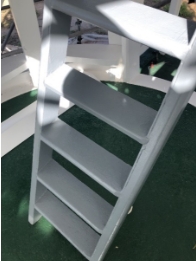
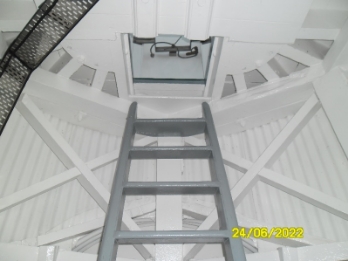
© AMSA, 2022
Description and condition
1886 fixed timber ladder.
Finish | painted |
Condition | intact and sound |
Integrity | high |
Significance | high |
Maintenance | keep in service, prepare and repaint at normal intervals |
Rectification works | none |
Heritage significance: High
The ladder is an original part of a lighthouse associated with the maritime history of the Torres Strait (criterion a).
The ladder is an original part of a lighthouse constructed entirely by government labour (criterion b).
The ladder is an original part of a lighthouse that demonstrates the principal characteristics of a late 19th century Queensland lighthouse (criterion d).
Lighthouse feature: Ground floor

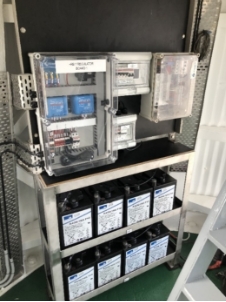
© AMSA, 2022
Description and condition
1886 concrete slab on fill retained by rendered stone rubble wall, with cast iron base ring for tower frame cast into it.
- Equipment – eight batteries on a galvanised steel rack inside the tower; control gear; cables
Finish | painted |
Condition | intact and sound |
Integrity | high |
Significance | high |
Maintenance | keep in service, prepare and repaint at normal intervals |
Rectification works | none |
Heritage significance: High
The ground floor is an original part of a lighthouse associated with the maritime history of the Torres Strait (criterion a).
The ground floor is an original part of a lighthouse constructed entirely by government labour (criterion b).
The ground floor is an original part of a lighthouse that demonstrates the principal characteristics of a late 19th century Queensland lighthouse (criterion d).
Lighthouse feature: Porch
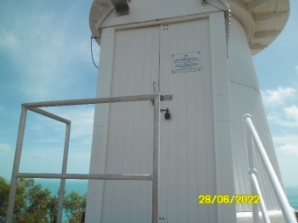
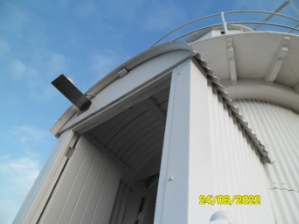 © AMSA, 2022
© AMSA, 2022
Description and condition
Timber framed, corrugated iron sheeted porch, with barrel-vaulted roof. Two timber framed and sheeted external doors. Roof cladding and wall cladding of porch replaced in 2006 and 2021.
Finish | painted |
Condition | corrosion at base of wall cladding, otherwise intact and sound |
Integrity | high |
Significance | high |
Maintenance | keep in service, prepare and repaint at normal intervals |
Rectification works | none |
Heritage significance: High
The porch is an original part of a lighthouse associated with the maritime history of the Torres Strait (criterion a).
The porch is an original part of a lighthouse constructed entirely by government labour (criterion b).
The porch is an original part of a lighthouse that demonstrates the principal characteristics of a late 19th century Queensland lighthouse (criterion d).
Lighthouse feature: Doors
 © AMSA, 2022
© AMSA, 2022
Description and condition
A pair of timber framed and sheeted doors. Timber hardwood doors re-constructed 2013 as per their replacement.
Finish | painted |
Condition | intact and sound |
Integrity | high |
Significance | high |
Maintenance | keep in service, prepare and repaint at normal intervals |
Rectification works | none |
Heritage significance: High
The doors are a replica of an original part of a lighthouse associated with the maritime history of the Torres Strait (criterion a).
The doors are a replica of an original part of a lighthouse constructed entirely by government labour (criterion b).
The doors are a replica of an original part of a lighthouse that demonstrates the principal characteristics of a late 19th century Queensland lighthouse (criterion d).
Lighthouse feature: Entry stairs
 © AMSA, 2022
© AMSA, 2022
Description and condition
Cement rendered rubble masonry stair treads, with later concrete ramp formed over one side. Recent welded aluminium platform and balustrade attached outside the porch doorway. Stainless steel handrail installed 2021.
Finish | bare aluminium other parts painted |
Condition | intact and sound |
Integrity | high |
Significance | aluminium and stainless steel parts: low other parts: high |
Maintenance | keep in service, prepare and repaint at normal intervals |
Rectification works | none |
Heritage significance: High
The entry stairs are an original part of a lighthouse associated with the maritime history of the Torres Strait (criterion a).
The entry stairs are an original part of a lighthouse constructed entirely by government labour (criterion b).
The entry stairs are an original part of a lighthouse that demonstrates the principal characteristics of a late 19th century Queensland lighthouse (criterion d).
Lighthouse feature: Solar panels
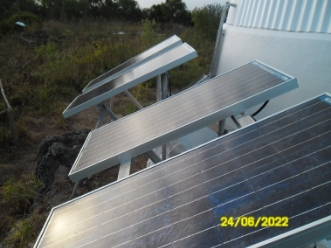 © AMSA, 2022
© AMSA, 2022
Description and condition
Four panels on two aluminium stands on the ground near the base of the tower.
Condition | intact and sound |
Integrity | high |
Significance | low |
Maintenance | keep in service |
Rectification works | none |
Heritage significance: Low
Lighthouse feature: Helipad
 © AMSA, 2022
© AMSA, 2022
Description and condition
Cast concrete slab encompassing parts of earlier building slabs.
Finish | trowelled bare concrete |
Condition | intact and sound |
Integrity | medium |
Significance | low |
Maintenance | keep in service, repaint helicopter marking as required |
Rectification works | none |
Heritage significance: Low
4.2 Related object and associated AMSA artefacts
There are currently no AMSA artefacts at Goods Island Lighthouse.
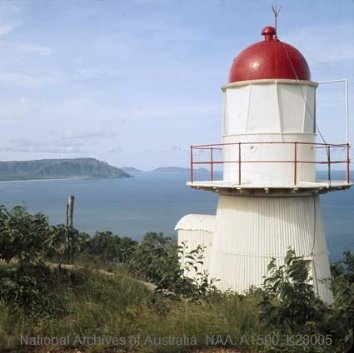
 Figure 13. Grassy Hill Lighthouse, Cooktown QLD, first lit 1886. Courtesy of the National Archives of Australia. NAA: A1500, K28005 (© Commonwealth of Australia, National Archives of Australia)
Figure 13. Grassy Hill Lighthouse, Cooktown QLD, first lit 1886. Courtesy of the National Archives of Australia. NAA: A1500, K28005 (© Commonwealth of Australia, National Archives of Australia)
Figure 14. Goods Island Lighthouse, Goods Island (Palilag) QLD, first lit 1887 (© AMSA, 2014)
4.3 Comparative analysis
The Goods Island Lighthouse can be usefully compared to a select number of other lighthouses located along the east coast of Australia, all within the state of Queensland.
Constructed over the period of 1886 to 1887, Goods Island Lighthouse is one of a group of only nine timber and light gauge corrugated galvanised iron sheeted (as opposed to riveted iron plated) composite lighthouses built in Queensland. This type of construction represents an innovation in Australian lighthouses and is a Queensland-based solution to the environment and lack of resources. Of the original nine lighthouses, only seven have survived. Of these, only three remain in their original locations and only two of these are still in operation – Goods Island Lighthouse and Grassy Hill Lighthouse. First lit in 1886, mere months prior to the completion of Goods Island, Grassy Hill Lighthouse still stands outside Cooktown. The galvanised iron sheeted lighthouse mirrors Goods Island’s design; complete with porch, entry stairs and red copula.
The other seven lighthouses include:
- Little Sea Hill Lighthouse I, Curtis Island (Deactivated c. 1960s, displayed at Gladstone Maritime Museum)
- Bay Rock Light, Halifax Bay (Deactivated c. 1980s, displayed at Townsville Maritime Museum)
- Gatcombe Head Light, Facing Island (Demolished)
- Little Sea Hill Light II, Curtis Island (Deactivated 2006)
- Old Caloundra Light, Caloundra (Deactivated 1968)
- North Point Light, Moreton Island (Demolished)
- Bulwer Island Light, Brisbane (Deactivated, displayed Queensland Maritime Museum)
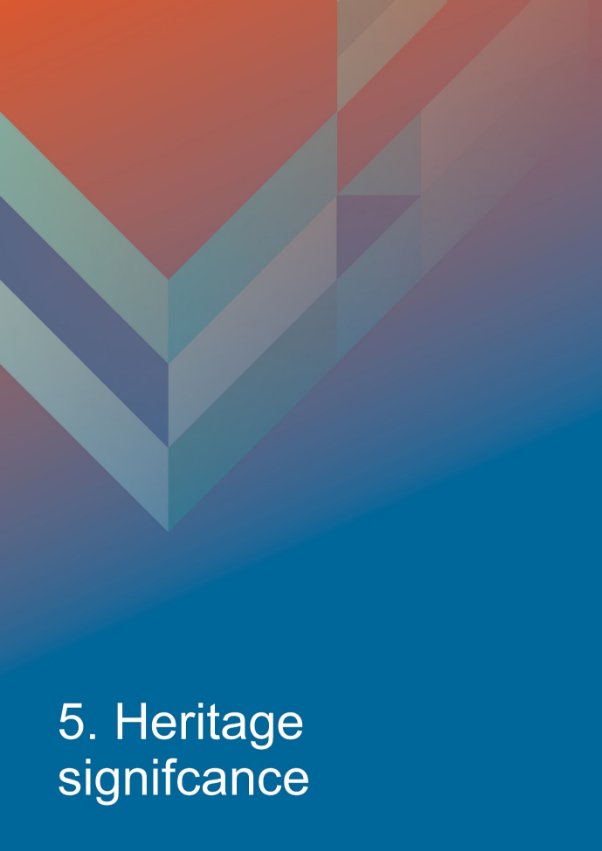
5. Heritage significance
5.1 Commonwealth heritage listing – Goods Island Lighthouse
The following information is taken directly from the Commonwealth Heritage listing for Goods Island Lighthouse (Place ID: 105458).
Commonwealth statement of significance
The following statement of significance is taken directly from Goods Island Lighthouse’s Commonwealth heritage listing:
A signalling station has existed on Goods Island (Palilag), in Torres Strait, since 1877. The present lighthouse was constructed at the highest point on the island in 1886. It is believed to be the only lighthouse in Queensland to have been constructed entirely by government labour. The lighthouse has been a key element of the maritime history of Torres Strait, ensuring the safety of vessels in Prince of Wales Passage and Normanby Sound for over 110 years. It played an important role in the days of World War 2, when Torres Strait was a vital location in Australia's defence against invasion by Japan. The light still operates, having been transferred to automatic function in 1973. (Criteria A.4, B.2. Historic Themes 3.8 Moving goods and people; 7.7.2 Preparing to face invasion).
With the exception of its automatic light, the Goods Island lighthouse demonstrates the principal characteristics of a late 19th Century Queensland lighthouse. The associated lightstation complex, including the lighthouse, the keeper’s quarters, the rear lead light contribute to this by illustrating important aspects of lightstation design concepts of the 1880s. (Criterion D.2).
Commonwealth heritage criteria
There are nine criteria for inclusion in the Commonwealth Heritage List, meeting any one of these is sufficient for listing a place. These criteria are similar to those used in other Commonwealth, state and local heritage legislation, although thresholds differ. In the following sections, Goods Island Lighthouse is discussed in relation to each of the criteria as based on the site’s current Commonwealth Heritage Listing (Place ID: 105458)
Criterion | Attributes | Explanation |
Criterion A) Processes This criterion is satisfied by places that have significant heritage value because of [their] importance in the course, or pattern, of Australia’s natural or cultural history. | The whole lighthouse, its setting and its prominent location. | A signalling station has existed on Goods Island (Palilag), in Torres Strait, since 1877. The present lighthouse was constructed at the highest point on the island in 1886 and has been a key element of the maritime history of Torres Strait, ensuring the safety of vessels in Prince of Wales Passage and Normanby Sound for over 110 years. It played an important role in the days of World War 2, when Torres Strait was a vital location in Australia's defence against invasion by Japan. The light still operates, having been transferred to automatic function in 1973. |
Criterion B) Rarity This criterion is satisfied by places that have significant heritage value because of [their] possession of uncommon, rare or endangered aspects of Australia’s natural or cultural history. | The building fabric, particularly the quality of construction. | Goods Island lighthouse is believed to be the only lighthouse in Queensland to have been constructed entirely by government labour. |
Criterion D) Characteristic value This criterion is satisfied by places that significant heritage value because of [their] importance in demonstrating the principal characteristics of: a class of Australia’s natural or cultural places; or a class of Australia’s natural or cultural environments | The lighthouse and its association with all aspects of the light station including the keeper's quarters and the rear lead light but excluding the automatic light. | With the exception of its automatic light, the Goods Island lighthouse demonstrates the principal characteristics of a late 19th Century Queensland lighthouse. The associated lightstation complex, including the lighthouse, the keeper’s quarters, the rear lead light contribute to this by illustrating important aspects of lightstation design concepts of the 1880s. |
These heritage values, identified and explained in the Commonwealth Heritage List, will form the basis of the management of Goods Island Lighthouse. In the event of necessary works, all criteria will be consulted to inform best practice management of the values associated with the lightstation. (See ‘Section 7. Conservation management policies for further information on strategies to conserve heritage values of Goods Island Lighthouse)
5.2 Condition and integrity of Commonwealth heritage values
A heritage monitoring program was implemented in 2016. Each site is visited and reviewed every two years where the heritage fabric and values of the site are evaluated. Assessment of the condition and integrity of lighthouse's Commonwealth heritage values are derived from the latest available Heritage asset condition report produced by AMSA’s maintenance contractor.
‘Condition’ is measured from good-fair-poor scale and incorporates the current condition of the specific value. Integrity is measured from high-medium-low and incorporates the value’s intactness. Goods Island Lighthouse’s Commonwealth heritage values and its associated attributes maintain good condition and high integrity.
The Commonwealth heritage values for Goods Island Lighthouse exhibits good condition and a high level of integrity. The lighthouse has retained much of its principal 19th century characteristics, and the tower maintains strong associations with the maritime history of the Torres Strait. Although outside of the AMSA lease, the surrounding building remnants are reminders of the island’s part in surveillance efforts during World War 2.
Value | Values (including attributes) | Condition | Integrity |
Criterion A) Processes | A signalling station has existed on Goods Island (Palilag), in Torres Strait, since 1877. The present lighthouse was constructed at the highest point on the island in 1886 and has been a key element of the maritime history of Torres Strait, ensuring the safety of vessels in Prince of Wales Passage and Normanby Sound for over 110 years. It played an important role in the days of World War 2, when Torres Strait was a vital location in Australia's defence against invasion by Japan. The light still operates, having been transferred to automatic function in 1973. (Criteria A.4, B.2.) | Good | High |
Criterion B) Rarity | Goods Island lighthouse is believed to be the only lighthouse in Queensland to have been constructed entirely by government labour. | Good | High |
Criterion D) Characteristic values | With the exception of its automatic light, the Goods Island lighthouse demonstrates the principal characteristics of a late 19th Century Queensland lighthouse. The associated lightstation complex, including the lighthouse, the keepers quarters, the rear lead light contribute to this by illustrating important aspects of lightstation design concepts of the 1880s. | Good | High |
5.3 Gain or loss of Commonwealth heritage values
As evidenced in Section 5.2, Goods Island Lighthouse’s identified Commonwealth Heritage values remain intact and in good condition.
In order to capture any gained Commonwealth Heritage values, a Heritage Place Review should be undertaken. At the time this plan was prepared, AMSA is planning a review program to be undertaken over a 5-year period.
Evidence of gained or lost of heritage values will be documented within this section in future versions of the plan.
5.4 Other heritage listings
Currently Goods Island Lighthouse is not listed on any State or local heritage registers.
Goods Island Lighthouse is listed on the non-statutory Register of the National Estate which was replaced by the Commonwealth Heritage List (Place ID: 101518).

6. Opportunities and constraints
6.1 Implications arising from significance
The Commonwealth statement of significance (section 5.1 above) demonstrates Goods Island Lighthouse is a place of considerable heritage value due to its association with the maritime history of the Torres Strait, its standing as the only known lighthouse entirely constructed by the State Government, and for the retention of its 19th century Queensland lighthouse characteristics.
The implication arising from this assessment is that key aspects of the place should be conserved to retain this significance. The key features requiring conservation include:
- architectural quality of the building
- the original lens assembly,
- interior features including:
- lantern room,
- ground floor,
- pedestal,
- ladder,
- porch
- exterior feature including:
- lantern roof,
- balcony (including balustrades),
- tower walls,
- windows and doors,
- entry stairs
Referral and approvals of action
The EPBC Act requires approval from the Minister for the Environment for all actions likely to have a significant impact on matters of National Environmental Significance (NES).
The Act provides that actions taken:
- on Commonwealth land which are likely to have a significant impact on the environment will require approval of the Minister.
- outside Commonwealth land which are likely to have a significant impact on the environment on Commonwealth land will require approval of the Minister.
- by the Australian Government or its agencies which are likely to have a significant impact on the environment anywhere will require approval of the Minister.
The definition of ‘environment’ in the EPBC Act and EPBC Regulations includes the cultural heritage values of places.
Heritage strategy
If an Australian Government agency owns or controls one or more places with Commonwealth heritage values, it must prepare a heritage strategy within two years from the first time they own or control a heritage place (section 341ZA).
A heritage strategy is a written document that integrates heritage conservation and management within an agency’s overall property planning and management framework. Its purpose is to help an agency manage and report on the steps it has taken to protect and conserve the Commonwealth heritage values of the properties under its ownership or control. The heritage strategy for AMSA’s AtoN assets was completed and approved by the Commonwealth Minister for the Environment in 2018 and reviewed in 2022. The latest version of the Strategy is available online.P37F[xlv]
Heritage asset condition report
A heritage asset condition report is a written document that details the heritage fabric of a site with an in-depth description of each architectural and structural element. The document includes: a brief history of the site, the Commonwealth Heritage statement of significance and value criteria, a heritage significance rating for each individual element, and a catalogue of artefacts on-site. The document is also accompanied by up-to-date photos of each structural element. This document operates as a tool for heritage monitoring and is reviewed and updated biennially.
Aboriginal heritage significance and natural values
Goods Island is notable for its Aboriginal heritage significance and natural values. Although these values lie outside of the Commonwealth heritage listing curtilage and AMSA’s lease, the potential remains for future works at the lighthouse to impact these values. At the time this plan was written, no plans have been made for future works at Goods Island Lighthouse. In the event major works at the lighthouse are required to be carried out, AMSA will seek to minimise impacts to the surrounding area by:
- Abiding by any relevant environment management plans for the marine park
- Consulting with Aboriginal stakeholders to ensure no significant sites are impacted
- Ensuring no damage is made to surrounding vegetation or animal habitats
- Ensuring project footprint is limited to the AMSA lease. In any instance that work is required outside of this footprint, approvals will be sought from the appropriate stakeholders.
- Implementing an appropriate discovery plan in the instance Aboriginal cultural heritage is suspected and/or found.
6.2 Framework: sensitivity to change
Owing to the site’s association with Queensland’s maritime history, its rarity as a lighthouse tower complete with residences built atop a coral reef, and its unique technical achievement due to the water tank at its base, Goods Island Lighthouse is of high significance. Therefore, work actioned by AMSA on the lighthouse’s fabric harnesses the potential to reduce or eradicate the significance of the site’s heritage values.
Conservation works, including restoration and reconstruction, or adaption works of the absolute minimum so as to continue the lighthouse’s usefulness as an AtoN are the only works that should be actioned by AMSA on Goods Island Lighthouse. Some exceptions are made for health and safety requirements, however any and all work carried out must be conducted in line with heritage considerations and requirements of the EPBC Act.
The table below demonstrates the level of sensitivity attributed to the various elements of the fabric register in the face of change. These are measured from high to low depending on the action’s possible threat to the site’s heritage values.
High sensitivity
High sensitivity to change includes instances wherein a change would pose a major threat to the heritage value of a specific fabric, or the lightstation as a whole. A major threat is one that would lead to substantial or total loss of the heritage value.
Moderate sensitivity
Moderate sensitivity to change includes instances wherein a change would pose a moderate threat to the heritage value of a specific fabric, or to the heritage significance of a specific fabric in another part of the building. A moderate threat is one that would diminish the heritage value or diminish the ability of an observer to appreciate the value.
Low sensitivity
Low sensitivity to change includes instances wherein a change would pose little to no threat to the heritage value of a specific fabric, or to the heritage significance in another part of the building.
Component | Level of sensitivity | Nature of change impacting heritage values |
Goods Island Lighthouse structure | High | - Reduction of visibility of structure and its setting on Goods Island.
- Major alterations to the colour scheme of the tower.
- Major design changes to lighthouse tower.
|
Low | - Removal of asbestos, lead paint and other toxic materials.
- Implementation of health and safety hazard markings.
- Repainting of structure in like-colours.
|
Ground floor (including ladder) | High | - Major alterations to concrete slab floor and cast iron base ring.
|
Low | - Repainting of ground floor in like colours.
- Removal/replacement of battery equipment from ground floor.
|
Ladder | High | - Major alterations to or removal of original timber ladder.
|
Low | - Repainting of ladder in like colours.
- Minor reparations to rotten timber with like-materials.
|
Lantern base | High | - Major alterations to 1886 timber frame base or iron plates.
- Major alterations to curved iron door.
- Major alterations to 1886 timber floor.
|
Low | - Repainting of lantern base and floor in like-colours.
- Corrosion reparations to lantern base walls and door.
- Reparations to rotten timber with like-materials.
|
Balcony and balustrades | High | - Major alterations to original balcony floor.
|
Medium | - Major alterations to balcony balustrades.
|
Low | - Replacement/reparations to wrought iron stanchion balustrades with like materials.
- Reparations to rotten timber with like-materials.
- Repainting of balcony floor and balustrades in like-colours.
|
Lantern glazing | High | - Major alterations to original astragals.
|
Low | - Replacement of broken glazing panes.
- Resealing of glazing.
- Repainting of astragals and glazing strips.
|
Lantern roof | High | - Major alterations to original dome, including ribs, ventilator, gutter and drip tray.
|
Low | - Repainting of lantern roof in like-colours.
- Corrosion reparations to lantern roof.
|
Lens assembly and light source | High | - Removal or replacement of 1886 Chance Brothers 250mm fixed lens.
|
Pedestal | High | - Major alterations to original cast iron pedestal.
|
Low | - Repainting of pedestal in like-colours.
|
Tower walls | High | - Major alterations to original timber frames.
- Major alterations to original conical form of tower.
|
Low | - Reparations to corroded iron sheeting with like-materials.
- Reparations to rotten timber frame.
- Repainting of timber frames and iron sheeting in like-colours.
|
Windows | High | - Major alterations to original window openings.
|
Low | - Repainting of sashes and frames in like-colours.
- Replacement of rotten timber frames with like-materials.
- Replacement of broken window panes.
|
Door | High | - Major alterations to original door opening.
|
Low | - Repainting of door in like-colours.
- Reparations to rotten timber doors and frame.
|
Porch | High | - Major alterations to porch design (including barrel-vaulted roof).
|
Low | - Repainting of timber frame and corrugated iron sheeting in like-colours.
- Reparations to rotten timber frames with like-materials.
- Corrosion reparations to iron sheeting.
- Replacement of 2006 roof and wall cladding with like-materials.
|
Entry stair | High | - Removal of or major alteration to entry stair.
|
| Low | - Replacement or removal of recent aluminium features.
- Repainting of stairs and ramp.
|
6.3 Statutory and legislative requirements
The following table lists the Acts and codes relevant to the management of Goods Island Lighthouse.
Act or code | Description |
Environment Protection and Biodiversity Conservation Act 1999 (Cth) | The Environment Protection & Biodiversity Conservation Act 1999 (Cth) requires agencies to prepare management plans that satisfy the obligations included in Schedule 7A and 7B of the EPBC Regulations. |
Environment Protection and Biodiversity Conservation Regulations 2000 (Cth) Schedule 7B | The Commonwealth Department of Agriculture, Water and the Environment has determined these principles as essential for guidance in managing heritage properties. - The objective in managing Commonwealth Heritage places is to identify, protect, conserve, present and transmit, to all generations, their Commonwealth Heritage values.
- The management of Commonwealth Heritage places should use the best available knowledge, skills and standards for those places, and include ongoing technical and community input to decisions and actions that may have a significant impact on their Commonwealth Heritage values.
- The management of Commonwealth Heritage places should respect all heritage values of the place and seek to integrate, where appropriate, any Commonwealth, state, territory and local government responsibilities for those places.
- The management of Commonwealth Heritage places should ensure that their use and presentation is consistent with the conservation of their Commonwealth Heritage values.
- The management of Commonwealth Heritage places should make timely and appropriate provision for community involvement, especially by people who:
(a) have a particular interest in, or associations with, the place; and (b) may be affected by the management of the place; - Indigenous people are the primary source of information on the value of their heritage and that the active participation of indigenous people in identification, assessment and management is integral to the effective protection of indigenous heritage values.
- The management of Commonwealth Heritage places should provide for regular monitoring, review and reporting on the conservation of Commonwealth Heritage values.
|
AMSA Heritage Strategy 2022-2025 | As the custodian of many iconic sites, the Australian Maritime Safety Authority (AMSA) has long recognised the importance of preserving their cultural heritage. This Heritage Strategy is in response to section 341ZA of the EPBC Act (1999) which obliges AMSA to prepare and maintain a heritage strategy, along with obliging AMSA to: - Assist in identification, assessment and monitoring of places of heritage value in its care;
- Prepare and maintain a register of its places of heritage value;
- Protect the heritage value of places when they are sold or leased;
- Provide this heritage strategy, and any subsequent major updates, to the relevant minister.
The strategy derives from the AMSA Corporate Plan and achievements are reported through the AMSA Annual Report. The 2020-21 AMSA Annual report can be found online.[xlvi] |
Navigation Act 2012 (Cth) | Part 5 of the Act outlines AMSA’s power to establish, maintain and inspect marine aids to navigation (such as Goods Island Lighthouse). (1) AMSA may: (a) establish and maintain aids to navigation; and (b) add to, alter or remove any aid to navigation that is owned or controlled by AMSA; and (c) vary the character of any aid to navigation that is owned or controlled by AMSA. (2) AMSA, or person authorised in writing by AMSA may, at any reasonable time of the day or night: (a) inspect any aid to navigation or any lamp or light which, in the opinion of AMSA or the authorised person, may affect the safety or convenience of navigation, whether the aid to navigation of the lamp or light is the property of: (i) a state or territory; or (ii) an agency of a state or territory; or (iii) any other person; and (b) enter any property, whether public or private, for the purposes of an inspection under paragraph (a); and (c) transport, or cause to be transported, any good through any property, whether public or private, for any purpose in connection with: (i) the maintenance of an aid to navigation that is owned or controlled by AMSA; or (ii) the establishment of any aid to navigation by AMSA. |
Australian Heritage Council Act 2003 (Cth) | This Act establishes the Australian Heritage Council, whose functions are: - to make assessments under Division 1A and 3A of Part 15 of the EPBC Act 1999;
- to advise the Minister on conserving and protecting places included, or being considered for inclusion, in the National Heritage List or Commonwealth Heritage List;
- to nominate places for inclusion in the National Heritage List or Commonwealth Heritage List;
- to promote the identification, assessment, conservation and monitoring of heritage;
- to keep the Register of the National Estate;
- to organise and engage in research and investigations necessary for the performance of its functions;
- to provide advice directly to any person or body or agency either if its own initiative of at the request of the Minister; and
- to make reports as outlined in the Act.
|
Building Code of Australia/National Construction Code | The Code is the definitive regulatory resource for building construction, providing a nationally accepted and uniform approach to technical requirements for the building industry. It specifies matters relating to building work in order to achieve a range of health and safety objectives, including fire safety. As far as possible, Commonwealth agencies aim to achieve compliance with the Code, although this may not be entirely possible because of the nature of and constraints provided by existing circumstances, such as an existing building. |
Work Health and Safety Act 2011 (Cth) | The objectives of this Act include: (1) The main object of this Act is to provide for a balanced and nationally consistent framework to secure the health and safety of workers and workplaces by: a) protecting workers and other persons against harm to their health, safety and welfare through the elimination or minimisation of risks arising from work; and b) providing for fair and effective workplace representation, consultation, co‑operation and issue resolution in relation to work health and safety; and c) encouraging unions and employer organisations to take a constructive role in promoting improvements in work health and safety practices, and assisting persons conducting businesses or undertakings and workers to achieve a healthier and safer working environment; and d) promoting the provision of advice, information, education and training in relation to work health and safety; and e) securing compliance with this Act through effective and appropriate compliance and enforcement measures; and f) ensuring appropriate scrutiny and review of actions taken by persons exercising powers and performing functions under this Act; and g) providing a framework for continuous improvement and progressively higher standards of work health and safety; and h) maintaining and strengthening the national harmonisation of laws relating to work health and safety and to facilitate a consistent national approach to work health and safety in this jurisdiction. (2) In furthering subsection (1)(a), regard must be had to the principle that workers and other persons should be given the highest level of protection against harm to their health, safety and welfare from hazards and risks arising from work as is reasonably practicable. [Quoted from Division 2 of Act] This has implications for Goods Island Lighthouse of Australia as it is related to AMSA staff, contractors and visitors. |
6.4 Operational requirements and occupier needs
As a working AtoN, the operational needs of Goods Island Lighthouse are primarily concerned with navigational requirements. Below are the operational details and requirements of the Goods Island light as outlined by AMSA.
Navigational requirement of AMSA’s AtoN site
The following table is taken from AMSA’s Asset Management Strategy for the Goods Island light.
1 | Objective/rationale | An AtoN is required on Goods Island to assist ships in the pilotage waters of the Torres Strait. To the West, the limit of the lit sector assists vessels to remain in the two-way route and to find the pilot station 4.7 miles to the west. It then warns of the island and the course alteration 1.6 miles to the west. To the North, it provides the rear transit light for vessels to check their compasses and a position line to check progress along track. To the South East it provides a light sector warning of West Wai Weer Reef. It also warns of offshore reefs and navigation hazards such as Harrison Rock to the north-west at 1.7 miles, Sunk Reefs to the north at 1.5 miles and Ipili Reef to the north-east at 1.5 miles. |
2 | Required type(s) of AtoN | A fixed structure is required to act as a day mark. A distinctive light is required for use at night. |
3 | Priority/significance | An AtoN at this site is important for the navigation of commercial ships. |
4 | Required measure of performance | The service performance of the AtoN must comply with the IALA Availability Target Category 1 (99.8%). |
5 | Primary and secondary means (if any) of identification | The day mark must be conspicuous. The existing 5 m high white round tower with a red cupola at an elevation of 105 m meets this requirement. The light must comply with the requirements of rhythmic characters of light as per the IALA NAVGUIDE. The light must have distinct characteristics that are easy to recognise and identify. The present flashing white light every 2.5 seconds, synchronized with Goods Islands Front Lead, meets this requirement. |
6 | Visual range | During daytime, the AtoN structure should be visible from at least 5 nautical miles. At night, the white light must have a nominal range of at least 14 nautical miles. |
7 | Radar conspicuousness | As the Island itself will provide a good radar echo, no additional radar enhancement is required for this site. |
AMSA’s goals
AMSA is responsible, under the Navigation Act, for maintaining a network of marine AtoN around Australia’s coastline that assist mariners to make safe and efficient passages. AMSA’s present network of approximately 500 marine AtoN includes traditional lighthouses such as Goods Island, beacons, buoys, racons, automatic identification system stations, metocean sensors including broadcasting tide gauges, current meter, directional wave rider buoys and a weather station.
Technological developments in the area of vessel traffic management have also contributed to increasing navigation safety and helped promote marine environment protection. AMSA aims to meet international standards for the reliability of lighthouses set by the International Association of Marine Aids to Navigation and Lighthouse Authorities (IALA).
At the time of preparing this management plan, the primary goal for Goods Island Lighthouse is to continue its utilisation as an AtoN (for as long as necessary), while upkeeping the appropriate maintenance to conserve and preserve the heritage values of the lighthouse.
Lighthouse performance standards
AMSA aims to meet international standards for the reliability of lighthouses set by IALA. Goods Island light is designated as an IALA Availability Category 1 AtoN (within a scale of Category 1 to Category 3, Category 1 aids are most critical). Category 1 aids have an availability target of 99.8 per cent.
Access to the lighthouse
One practical effect of this performance standard is that the operational equipment and structure of the light must be kept in good repair by regular maintenance. Routine maintenance and emergency repairs, when equipment fails in service, are carried out by AMSA’s maintenance contractor. The contractor needs reliable access to the site for this work, and AMSA officers need access for occasional inspections of the site including to audit the contractor’s performance.
6.5 Proposals for change
Preventative maintenance works are carried out on the lighthouse to maintain its status as a working marine AtoN, and to assist in the site’s conservation.
A list of scheduled preventative maintenance work is identified within the latest available site inspection report. The information provided below was taken from this report.
Maintenance | Estimated maintenance date |
Solar panel changeout | 2027 |
Lantern room paint | 2027 |
Structure Paint | 2027 |
6.6 Potential pressures
A significant pressure that harnesses the potential to effect the Commonwealth heritage values of the place would be the obligation to remove or replace original fabric materials from the lighthouse owing to unavoidable and irreversible deterioration. At the time of preparing this management plan, no plans have been made to remove original fabric material. In the event plans are made to modify or remove original fabric, work will be conducted in line with the heritage considerations and requirements of the EPBC Act.
6.7 Processes for decision-making
Processes for decision-making are required in the event of an incident that impacts the heritage values of the site. The following incidents are included due to their likelihood of occurrence at Goods Island Lighthouse.
Incident | Procedure |
Major project/maintenance works proposed | - Prepare Heritage Impact Statement on proposed modifications.
- Submit scope of works and Heritage Impact Statement to the Department of Agriculture, Water and the Environment for review.
|
Damage to lighthouse’s fabric (heritage significance) | - AMSA or selected contractors assess extent of damage.
- Seek heritage advice on restoration of impacted heritage fabric.
- Identify possible loss of heritage value (at both state and Commonwealth level).
- Seek the appropriate approvals for restoration of heritage fabric impacted.
- Implement best-practice management of restoration work in keeping with the original character of the place.
- In the case of a loss of heritage value, prepare report for submission.
- Update record-keeping of incident and make available to relevant personnel.
|
Damage to lighthouse’s fabric (no heritage significance) | - AMSA or selected contractors to assess extent of damage.
- Identify possible impact on heritage fabric in any work carried out to restore non-significant fabric.
- Implement best-practice management of restoration work.
- Update record-keeping of incident and make available to relevant personnel.
|
Light upgrade | - Assess possible loss of heritage value in the event of an upgrade.
- If necessary, seek expert heritage advice on process of upgrade.
- If necessary, seek heritage approvals for the upgrade of light.
- Implement best-practice management of light upgrade work.
- Update record-keeping and make available to relevant personnel.
|
Minor modification to lighthouse (such as adding of attachment) | - Assess possible obstruction to light.
- Seek heritage approvals for attachment to tower.
- Monitor attachment and update record-keeping.
|
Unforeseen discovery of Aboriginal artefacts on-site. | - Immediate stop-work.
- Notify appropriate Kurareg and QLD State Government.
- Delay work on site until artefacts have been appropriately assessed and/or extracted and further investigations carried out in surrounding area.
- Update record-keeping of unforeseen discovery and make available to relevant personnel.
|
Divestment of lighthouse from AMSA | - Transfer ownership or control of heritage assets to the State of Queensland.
- Terminate lease of site.
- Transfer relevant records and historical information held by AMSA to the State of Queensland.
|
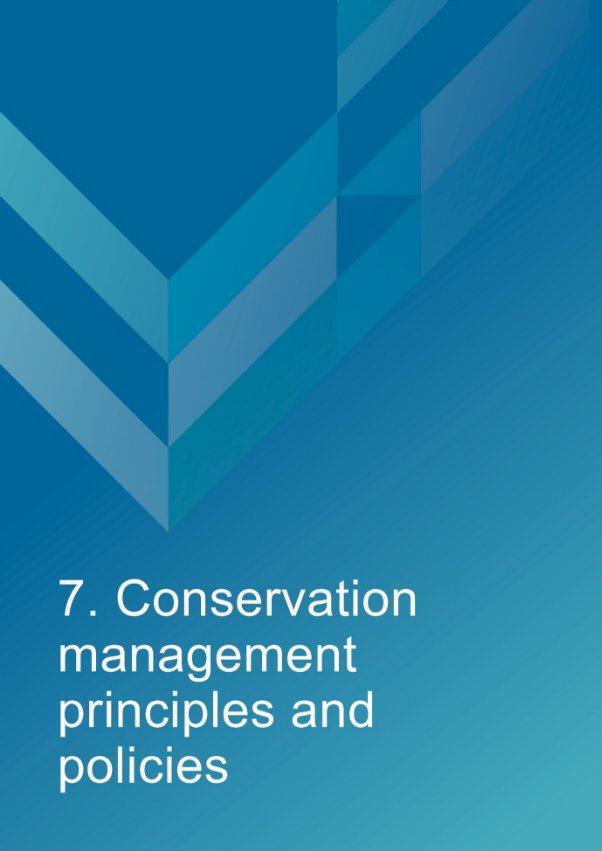
7. Conservation management principles and policies
Policies
Note: The management of sensitive information is not relevant to AMSA’s heritage strategy and therefore bears no relevance in this management plan.
Fabric and setting
Policy 1 – Protect and conserve the significant external and internal fabric of the lighthouse, including existing buildings, layout and setting.
AMSA’s main purpose is to facilitate the ongoing operation of the site as a marine AtoN while preserving the site’s heritage values. As part of a heritage monitoring program, Heritage Asset Condition Reports are produced for each site every two years to evaluate the condition of the heritage fabric and values. Routine servicing is also carried out by maintenance contractors. Regular written reports from these visits will be sent to AMSA Asset Management and Preparedness for review and any work requirements identified will be scheduled accordingly. Should for some unforeseen reason the site no longer be viable as a marine AtoN, ownership will be passed to an appropriate state or federal authority to ensure preservation of the heritage assets.
Implementation strategy:
- AtoN Maintenance Contractor will continue scheduled periodic maintenance of the lighthouse and marine aids to navigation every 12 months to ensure condition is monitored for early warning of deterioration. Schedule must be approved by AMSA Asset Management and Preparedness.
- AMSA Asset Management and Preparedness to arrange for maintenance to be carried out on the lighthouse as required while continuing to operate as an AMSA marine AtoN.
- AMSA Asset Management and Preparedness to continue the scheduled heritage monitoring visits to Goods Island Lighthouse and review of the Heritage Asset Condition Reports every two years.
- AMSA Asset Management and Preparedness to arrange for the replacement and upgrading of marine AtoN equipment in the lighthouse as required to meet AMSA’s service commitment, in a manner that preserves the original fabric of the lighthouse.
- AMSA Asset Management and Preparedness to maintain information on the heritage fabric of the lighthouse including any and all actions, treatments and inspection outcomes within the heritage fabric register. See ‘Section 4.1 for Fabric register’.
- AMSA Asset Management and Preparedness to conserve all the fabric elements identified as significant in the heritage asset condition report.
- AMSA Asset Management and Preparedness to seek expert materials conservation advice when considering repair, restoration and reconstruction of historic fabric. The relevant local, state and Commonwealth heritage approvals must be sought prior to repair, restoration and reconstruction.
- AMSA AtoN Heritage Coordinator to conserve the distinctive character of the lightstation by collecting photographic evidence and historical documentation of the original fabric.
- AtoN Maintenance Contractor to continue scheduled heritage monitoring visits to Goods Island and update Heritage Asset Condition Reports.
Uses
Policy 2 – Install and operate equipment in the lighthouse, so it continues to function as an effective marine AtoN, in such a way as to impose the least possible harm to the significant fabric.
Goods Island Lighthouse’s use as a working marine AtoN is of high priority. Carrying out maintenance, including upgrades to navigational equipment, is necessary to its function and continued marine safety along the QLD coast. In the event of the installation or upgrade to AtoN equipment, proper precaution will be taken to ensure the least possible harm is done to significant fabric.
Implementation strategy:
- AtoN Maintenance Contractor to monitor Goods Island’s AtoN equipment every 12 months and propose maintenance in the instance of necessary installation or removal. Proposed maintenance is to be approved by AMSA Asset Management and Preparedness.
- AtoN Maintenance Contractor and AMSA Asset Management and Preparedness to outline all possible risks to significant fabric (external and internal) associated with the installation, removal and operation of navigational equipment.
- AMSA Asset Management and Preparedness to ensure works carried out are those that ensure the least possible harm to significant fabric.
- AMSA Asset Management and Preparedness to seek expert heritage conservation advice on best practice management of the site during installation, removal and operation of AtoN equipment.
Policy 3 – Monitor possible impacts to the site resulting from tourism and control appropriate access to the lighthouse for contractors and visitors.
Goods Island Lighthouse is not currently open as a tourist site and access inside the lighthouse is restricted to authorised personnel, such as contractors and AMSA employees. AMSA personnel and contractors require easy access to the island and inside the lighthouse tower for periodical site visits to carry out inspections and routine maintenance.
Implementation strategy:
- AtoN Maintenance Contractor to ensure control of access to all buildings within the AMSA lease area is maintained by periodically inspecting restricted access areas during maintenance visits every 12 months.
- AtoN Maintenance Contractor to inspect lighthouse for signs of wear and tear attributed to visitor intake during yearly maintenance visit and note changes in the Heritage Asset Condition Report.
- AMSA Asset Management and Preparedness to ensure access to the lightstation complies with workplace health and safety measures.
- AMSA Asset Management and Preparedness to ensure contractors are made aware of the heritage values of the lighthouse.
- AMSA Asset Management and Preparedness to ensure access to site is available for Traditional Owners to maintain cultural traditions.
Interpretation
Policy 4 – Accurate and relevant interpretation of the history and significance of the place should be made available to site users/visitors and for offsite external research.
AMSA will continue to make information available through the maintenance of site interpretive signage and its website.
Implementation strategy:
- All relevant information concerning the history and significance of the place will be checked for accuracy and updated appropriately.
- Information will be presented primarily as online resources accessible to relevant personnel and the general public. On-site interpretative signage will be installed where possible.
- This information will be maintained and updated in accordance with changes to the history and significance of the place.
Management
Policy 5 – AMSA will continue to conserve the lighthouse in accordance with Commonwealth heritage listing requirements.
For works requiring heritage approval, AMSA will obtain permission from any relevant state or federal authorities. Continuous and as-needed conservation works will be undertaken as required.
Implementation strategy:
- Liaise with the Department of Climate Change, Energy, the Environment and Water (Heritage Branch) when proposing work on the site.
- Approval in writing from the relevant Commonwealth and State heritage authorities must be granted for any proposals for development.
Policy 6 – The cultural significance of the lightstation will be the basis for deciding how to manage it.
The heritage values or cultural significance of the place must be conserved. This heritage management plan includes relevant background information to support this policy (see ‘Section 3 History’).
Implementation strategy:
- Conserve the lighthouse to protect its heritage values (cultural significance)
- When possible, strive to maintain the original fabric of the lighthouse
- Use the Burra Charter as the primary guide for treatment of fabric
- Engage appropriately qualified heritage consultants when making decisions regarding impact on heritage values
- Assess impacts on the heritage values of the place when considering proposed alterations or adaptations.
Policy 7 – Monitor, review and report the condition of Commonwealth heritage values of the lighthouse every five years or sooner if major changes to the lightstation occur.
The Commonwealth heritage values of the lighthouse are to be monitored and reported on a regular basis. A Heritage Asset Condition Report is updated for Goods Island Lighthouse every two years. The report records historical information, condition, and maintenance requirements for fabric within the lighthouse to ensure a gain and/or loss of heritage value is identified.
Implementation strategy:
- AMSA Asset Management and Preparedness to regularly monitor the lighthouse for possible impacts on the identified Commonwealth heritage values.
- AtoN Maintenance Contractor to update the Heritage Asset Condition Report every two years, and AMSA AtoN Heritage Coordinator to review the reports.
- AMSA Asset Management and Preparedness to review the current Commonwealth heritage values at least once every five years and assess any gain/loss of values. This review must be undertaken in the event of any major alterations to the lighthouse.
- AMSA Asset Management and Preparedness to report any changes to the Commonwealth heritage values of the lightstation to the DCCEEW (Heritage Branch).
- AMSA Asset Management and Preparedness to update AMSA’s Heritage Strategy and this plan to reflect any changes identified.
Policy 8 – Maintain historical, management and maintenance records within AMSA and make available these records.
As part of the proper process for managing change in significant places, the Burra Charter points out the importance of making records before any change, and advocates placing records in a permanent archive and making them available where this is appropriate. AMSA’s collection of records, which include documents pertaining to heritage intervention, management and maintenance, are subject to this process. Heritage Asset Condition Reports are routinely generated for each heritage lighthouse and stored in AMSA’s record-keeping system. AMSA will continue to practice such processes via their records management systems (RMS).
Implementation strategy:
- AMSA Asset Management and Preparedness to maintain, review and update records through existing AMSA RMS.
- AMSA Asset Management and Preparedness to ensure records are made available to the relevant personnel and parties.
Policy 9 – Develop and provide appropriate training and resources to all relevant AMSA staff, contractors and licensees.
In order to ensure best practice management of AMSA-operated lighthouses, all staff, contractors and licensees are required to have access to the appropriate training and resources in order to provide best practice conservation of the site.
Implementation strategy:
- AMSA Asset Management and Preparedness to provide staff, contractors and licensees access to up-to-date versions of the AMSA heritage strategy, heritage management plans and fabric registers.
- When funds are made available, AMSA Asset Management and Preparedness staff will undertake the appropriate training to ensure comprehension of the Commonwealth heritage and EPBC Act statutory requirements.
- Develop and provide appropriate training for contractors engaged with heritage sites to ensure comprehension of the Commonwealth heritage and EPBC Act statutory requirements.
- AMSA representatives will attend Commonwealth-run heritage workshops, programs and conferences for up-to-date information on statutory requirements and best-practice management of sites of national and state heritage significance.
Policy 10 – Use contractors and service providers with appropriate experience.
AMSA is to ensure parties carrying out work have appropriate knowledge and use effective methods to ensure conservation of the lighthouse.
Implementation strategy:
- Engage staff and contractors with the relevant experience and expertise concerning conservation of the lightstation.
- Develop and provide the appropriate training on heritage conservation matters for AMSA Asset Management and Preparedness staff and other relevant parties who hold responsibility for heritage management.
Policy 11 – Seek heritage advice and apply best heritage practice.
AMSA will continue to use in-house heritage expertise, external consultancy, or a combination of both as required in order to successfully apply best heritage practice. Should in-house heritage expertise be limited in responding to a requirement, external heritage expertise will be engaged to address the issue.
Implementation strategy:
- Apply in-house heritage expertise when required.
- Use tools such as the Burra Charter and Working Together: Managing Commonwealth Heritage Places[xlvii] to measure the likely impact of proposals.
- Seek external heritage expertise in the event of limited in-house capability.
Policy 12 – Appropriate protocol in the event of unforeseen discoveries or disturbances of heritage within the AMSA site.
AMSA’s scope of work rarely involves excavation. Should such work need be undertaken, AMSA will implement a suitable discovery plan and seek advice from suitably qualified personnel as required. In the event of any unforeseen discovery or disturbance of heritage-related items on the AMSA site, notification to the appropriate organisation will occur in accordance with the conditions of the discovery plan. This plan will also be updated accordingly.
Note: In most cases, AMSA’s leases are limited to the immediate vicinity of the lighthouse and therefore this scenario is not anticipated as a likely occurrence.
Implementation strategy:
- Consult with Kaurareg in the event Aboriginal heritage is suspected and/or found.
- Seek appropriate heritage advice and apply best practice in the event of unforeseen discoveries/disturbances.
Policy 13 – Make this heritage management plan available to all persons involved in decision-making on the management of the lighthouse and its setting.
The plan will be made available to all personnel intrinsic to management of the lighthouse and its setting, for example AMSA maintenance contractors, staff and other relevant parties.
Implementation strategy:
- Provide links to this plan via the AMSA website
- Provide copies to all relevant personnel and parties.
Future developments
Policy 14 – Adaptation of the place using methods or processes that minimise impact on heritage values and significance in accordance with the Burra Charter principles.
It is likely that over time the lighthouse will house new equipment as technology changes and improves. The Burra Charter principles will be used as the basis for decision-making.
Implementation strategy:
- Assess the likely impacts of changes on the heritage values and significance of the place
- Preserve the original fabric of the place and do only what is necessary for the continued use and care of the place
- Engage expert heritage advice and use the Burra Charter in adapting the place.
Policy 15 – When required, engage with adjacent landowners to maintain an appropriate setting for the lighthouse in its visual and natural context.
Any changes to the surrounding land, or AMSA leased area, requires careful consideration. AMSA will liaise with all adjacent landowners in the event of any proposed changes that may affect the setting and attempt to influence a positive outcome.
Implementation strategy:
- AMSA Asset Management and Preparedness to engage with Kaurareg and adjacent landowners through consultation when changes are proposed regarding the wider visual and natural context.
Policy 16 – In the event of adaptive re-use or divestment (an instance(s) which would no longer place the lighthouse under AMSA control), AMSA will strive to ensure the Commonwealth heritage values of the site are recognised and preserved.
In the event Goods Island Lighthouse is no longer identified as a working AtoN, AMSA will withdraw its standing as lessee and hand over all authority to the lessor. This process must be conducted in line with s 341ZE of the EPBC Act.
Implementation strategy:
- AMSA will negotiate with lessor to have site lease terminated.
- All available heritage information within AMSA’s collection, including this heritage management plan, will be shared with the relevant parties to ensure the Commonwealth heritage values of the site are recognised and preserved.
Community Involvement
Policy 17 – Consult with Traditional Owners and community stakeholders in the preparation of the management plan.
AMSA will give Traditional Owners and community groups, as well as the general public, an opportunity to review and comment on this management plan through a public consultation process.
Implementation strategy:
- Undertake community consultation when preparing the heritage management plan in accordance with EPBC Regulations.
- Seek advice from all relevant Traditional Owners and refer to Engage Early—Guidance for proponents on best practice Indigenous engagement for environmental assessments under the Environment Protection and Biodiversity Conservation Act 1999 (EPBC Act)[xlviii] to guide consultations.
Review
Policy 18 – Review this plan within five years of its adoption or sooner if major changes are needed.
This plan will be reviewed every five years. This review should:
- assess the content of the plan.
- determine its effectiveness in protecting the identified heritage values
- provide any necessary recommendations for updating or re-writing of the plan. If major changes occur at the site in the interim, this plan will be reviewed and updated earlier than the specified five years.
Implementation strategy:
- AMSA Asset Management and Preparedness to review this heritage management plan at least five years after its adoption.
- AMSA Asset Management and Preparedness to review and update this heritage management plan in the event of a major change to the lightstation.
- AMSA Asset Management and Preparedness to summarise changes implemented within updated plan.
- AMSA Asset Management and Preparedness to submit revised plan for approval.

8. Policy implementation plan
8.1 Plan and schedule
Key Issue | Management action/task | Policies | Responsibility | Priority | Timeframe |
Conservation and preservation | Conserve the lighthouse. | 1, 2, 3, 5, 6, 10, 11, 14 | AMSA, Asset Management and Preparedness | High | On-going |
Review the heritage management plan every five years. | 18 | AMSA, AtoN Heritage Coordinator | Medium | 2028 (5 years (minimum) |
Make this plan available to all relevant personnel. | 7, 13 | AMSA, AtoN Heritage Coordinator | High | Ongoing |
Liaison dealings | If applicable, ensure communication is maintained with adjacent landowners. | 15 | AMSA, Asset Management and Preparedness | Medium | As required |
Consult with Traditional owners and community stakeholders in preparing the management plan. | 17 | AMSA, AtoN Heritage Coordinator | Medium | As required |
Heritage values | Review the Commonwealth heritage values every five years. | 7 | AMSA, AtoN Heritage Coordinator | High | 2028 |
Consider heritage values when proposing new planning and/or developments. | 5, 6, 7, 14 | AMSA, AtoN Heritage Coordinator and Project Managers | High | Ongoing |
Ensure process of re-use or divestment of the site recognises and preserves heritage values. | 16 | AMSA, AtoN Heritage Coordinator | High | As required |
Conduct heritage monitoring site visit and review Heritage Asset Condition Report every two years. | 1, 7 | AMSA, AtoN Heritage Coordinator | High | Once every two years (ongoing) |
Staff and community awareness | Provide relevant training and awareness for management personnel (contractors and site-users). | 9 | AMSA, Asset Management and Preparedness | High | As required |
Ensure the availability of accurate and relevant information on the history and significance of the lightstation for site-users and visitors. | 4 | AMSA, AtoN Heritage Coordinator | Medium | Ongoing |
Record-keeping/access | Maintain adequate record-keeping of historical, management and maintenance documents. Make these records available. | 8 | AMSA, Asset Management and Preparedness | High | Ongoing |
Expert heritage advice | Ensure knowledge and advice of heritage experts is used. | 10, 11 | AMSA, Asset Management and Preparedness | Medium | As required |
Lighthouse maintenance | Schedule periodic maintenance. | 1 | AMSA, Asset Management and Preparedness | High | Ongoing (reoccurring once every 12 months) |
The implementation of unforeseen discovery or disturbance processes in the event of an accidental discovery. | 12 | AMSA, Asset Management and Preparedness | Medium | As required |
Lightstation access | Secure appropriate access to lightstation for contractor and visitors. | 3 | AMSA, Asset Management and Preparedness | Medium | As required |
8.2 Monitoring and reporting
As stipulated by Schedule 7A of the EPBC Regulations, the outlined implementation plan and associated policies listed above are required to be monitored and updated accordingly. The below review process timetable will be adhered to over the next five years:
Timeframe | Review step | Responsibility |
2026 | Plan’s half-life internal review: - Assess strengths and weaknesses of existing plan
- Address any known impact to the lighthouse’s heritage values
| AMSA, Asset Management and Preparedness |
2028 | Plan’s full-life review: - Consult with internal and external stakeholders on existing plan
- Prepare updated draft plan and consult with the Heritage Branch
- Submit reviewed plan to the Minister
| AMSA, Asset Management and Preparedness |
Other key actions in monitoring and reporting include:
- ensuring the implementation plan and policies are readily available for all relevant personnel
- delegating AMSA staff to periodically check the implementation plan is up-to-date and being utilised appropriately by the relevant personnel
- ensuring the timeframes outlined within the plan are followed
- delegating AMSA Response staff to review this plan and the associated policies at least every five years and determine whether its contents are relevant and effective in terms of continuing to conserve the place.

Appendix 1. Glossary of heritage conservation terms
The Burra Charter, from its first version (1979) and its current version (2013), defined a set of terms that have since been widely adopted in Australian heritage conservation practice.
Where the following terms are used in this heritage management plan, the particular meanings defined in the charter are intended. The definitions are quoted from Article 1 of the Burra Charter[xlix].
Adaptation means modifying a place to suit the existing use or a proposed use.
Associations means the special connections that exist between people and a place.
Compatible use means a use which respects the cultural significance of a place. Such a use involves no, or minimal, impact on cultural significance.
Conservation means all the processes of looking after a place to retain its cultural significance.
Cultural significance means aesthetic, historic, scientific, social or spiritual value for past, present or future generations. Cultural significance is embodied in the place itself, its fabric, setting, use, associations, meanings, records, related places and related objects. Places may have a range of values for different individuals or groups.
Fabric means all the physical material of the place including components, fixtures, contents, and objects.
Interpretation means all the ways of presenting the cultural significance of a place.
Maintenance means the continuous protective care of a place and its setting. Maintenance is to be distinguished from repair which involves restoration or reconstruction.
Meanings denote what a place signifies, indicates, evokes or expresses to.
Place means a geographically defined area. It may include elements, objects, spaces and view. Place may have tangible and intangible dimensions.
Preservation means maintaining a place in its existing state and retarding deterioration.
Reconstruction means returning a place to a known earlier state and is distinguished from restoration by the introduction of new material.
Related object means an object that contributes to the cultural significance of a place but is not at the place.
Related place means a place that contributes to the cultural significance of another place.
Restoration means returning a place to a known earlier state by removing accretions or by reassembling existing elements without the introduction of new material.
Setting means the immediate and extended environment of a place that is part of or contributes to its cultural significance and distinctive character.
Use means the functions of a place, including the activities and traditional and customary practices that may occur at the place or are dependant on the place.
Appendix 2. Glossary of historic lighthouse terms relevant to Goods Island Lighthouse
A
Apron paving – the concrete paving surrounding the base of the lighthouse tower.
Astragal – the bars which support the glazing of a lantern. They may also support the roof. A frame between the glazing bars in the lantern glazing. In its true meaning an astragal is a moulding that has a rounded profile. In lanterns this is almost never the case.
B
Balcony – a walkway around the outside of the lantern, used for maintenance and (formerly, when lighthouses were manned) for observing ships. Principal parts are the balcony floor and the balcony balustrade. (Synonym: gallery deck).
Balcony floor – floor of the balcony. Goods Island has a balcony floor of 1886 timber.
Balcony balustrade – a handrail together with its supports. The supports are called balusters. Simply a railing or wall on the outer perimeter of the balcony, to prevent people from falling off the balcony. Generally made of metal stanchions and rails – Goods Island has balcony balustrades of solid wrought iron.
Balcony door – door in the lantern base to give access to the balcony. In AMSA lanterns two doors are sometimes fitted but only one is operational. (Synonym: parapet hatch, service room door). Goods Island has a lantern door of curved iron plate.
C
Candelas – International unit of measurement for the luminous intensity of a light.
Cast iron – a mixture of iron and carbon with a relatively high carbon content and a low melting point, produced directly from a blast furnace.
Chance Bros – English manufacturer of optical apparatus, lanterns, cast iron stairs, cast iron towers, and other lighthouse components. The Chance family established a glass-making business in Smethwick, England in 1824 and is often described as ‘near Birmingham’. The business was absorbed into the Pilkington group of companies in 1951 and now ceases to exist.
Character – pattern of flashes of light emitted by a lighthouse, designed to identify that particular lighthouse.
Copper – a red malleable metal of low resistivity.
I
Intensity – the strength of a light measured by candelas.
Iron – there were two common types of iron used in lighthouse construction; wrought and cast. Older lights will almost certainly contain these iron types. Wrought iron has been worked by hand and is an iron alloy with a very low carbon content in contrast to steel, it also has fibrous inclusions. Cast iron is iron which has been heated until it liquefies and is then poured into a mould to solidify.
Iron Caisson - a large watertight chamber, open at the bottom, from which the water is kept out by air pressure.
L
Lantern – the glazed enclosure, usually of cylindrical or polygonal shape, at the top of a lighthouse, which surrounds and protects the optical apparatus. It contains the optical apparatus, made up of the lantern roof, lantern glazing and lantern base sections.
Lantern floor – the level in a lighthouse at which the lantern is installed, and by which access may be gained to the optical system and to the inside and outside of the lantern glazing. The lantern floor is generally at or near the same level as the catwalk and cane be made from steel, concrete, or timber. Goods Island has a lantern floor of 1886 timber.
Lantern glazing – the middle section of the lantern, circular or polygonal in plan, between the lantern roof above and the lantern base below, made up of glass panes held in a framework of glazing bars. On the landward side there may be blank panels in place of glass, or other opaque construction. Types of lantern glazing include: flat & curved trapezoidal panes and curved diamond/triangular panes. Goods Island has flat trapezoidal glazing panes.
Lantern roof – the roof of the lantern. Usually made of copper sheeting over a framework of rafters.
Lens assembly – a transparent optically refracting element of glass. The surface is usually spherical in form.
Light source – electric bulbs now illuminate most lighthouses.
Lighthouse – the principal structure of a lightstation, generally made up of a lantern, balcony and tower.
Lightstation – a precinct containing a lighthouse structure and other related buildings, for example. Keepers’ cottages, storeroom, signal house.
O
Order – a shorthand expression of the size of an optical apparatus or lantern. At the time the system of orders was established, when kerosene burners were used, longer range lights needed larger burners, and larger burners needed lens assemblies of longer focal length to ensure a sharply defined beam. Thus, in turn, the lantern rooms were required to be larger to house these lens assemblies. AMSA historic lantern rooms range from 1st to 4th order.
P
Pedestal – part of the optical apparatus, consisting of a metal column or base standing on the balcony floor inside the lantern and supporting the lens assembly and light source. Some later Chance documentation (such as their tariffs 1908) also refer to the lantern base as a pedestal.
Porch – Small entry room at front entrance of lighthouse tower. Typical of some Queensland lighthouses built late-19th century.
T
Tower – structure to support the lantern at a sufficient height above the ground. The most common types are the masonry tower, timber-framed tower, cast iron tower, and lattice tower. Goods Island has tower walls consisting of 1886 timber frame and corrugated iron sheeting.
Appendix 3. Table demonstrating compliance with the EPBC Regulations
Environment Protection and Biodiversity Conservation Regulations 2000 (Cth) Schedule 7A – Management Plans for Commonwealth Heritage Places |
Legislation | Satisfied within |
A management plan must: |
(a) Establish objectives for the identification, protection, conservation, presentation and transmission of the Commonwealth Heritage values of the place | Section 1 – Introduction |
(b) Provide a management framework that includes reference to any statutory requirements and agency mechanisms for the protection of the Commonwealth heritage values of the place | Section 1 – Introduction |
(c) Provide a comprehensive description of the place, including information about its location, physical features, condition, historical context and current uses | Section 2 – Goods Island Lighthouse site Section 3 - History Section 4 - Fabric |
(d) Provide a description of the Commonwealth heritage values and any other heritage values of the place | Section 5 – Heritage significance |
(e) Describe the condition of the Commonwealth heritage values of the place | Section 5 – Heritage significance |
(f) Describe the method used to assess the Commonwealth heritage values of the place | Section 5 – Heritage significance |
(g) Describe the current management requirements and goals including proposals for change and any potential pressures on the Commonwealth heritage values of the place | Section 6 – Opportunities and constraints |
(h) Have policies to manage the Commonwealth heritage values of a place, and include in those policies, guidance in relation to the following: | |
i. The management and conservation processes to be used | Section 7 – Conservation management principles and policies (Policy 1, 2, 3, 5, 6, 10, 11, 14) |
ii. The access and security arrangements, including access to the area for indigenous people to maintain cultural traditions | Section 7 – Conservation management principles and policies (Policy 3) |
iii. The stakeholder and community consultation and liaison arrangements | Section 7 – Conservation management principles and policies (Policy 15, 17) |
iv. The policies and protocols to ensure that indigenous people participate in the management process | Section 7- Conservation management principles and policies (Policy 17) |
v. The protocols for the management of sensitive information | Not Applicable |
vi. The planning and management of works, development, adaptive reuse and property divestment proposals | Section 7 – Conservation management principles and policies (Policy 16) |
vii. How unforeseen discoveries or disturbances of heritage are to be managed | Section 7 – Conservation management principles and policies (Policy 12) |
viii. How, and under what circumstances, heritage advice is to be obtained | Section 7 – Conservation management principles and policies (Policy 10, 11) |
ix. How the condition of Commonwealth heritage values is to be monitored and reported | Section 7- Conservation management principles and policies (Policy 5, 6, 7, 14) |
x. How records of intervention and maintenance of a heritage places register are kept | Section 7 – Conservation management principles and policies (Policy 7, 13) |
xi. The research, training and resources needed to improve management | Section 7 – Conservation management principles and policies (Policy 9) |
xii. How heritage values are to be interpreted and promoted | Section 7 – Conservation management principles and policies (Policy 4) |
(i) Include an implementation plan | Section 8 – Policy implementation plan |
(j) Show how the implementation of policies will be monitored | Section 8 – Policy implementation plan |
(k) Show how the management plan will be reviewed. | Section 7 – Conservation management principles and policies (Policy 18) Section 8 – Policy implementation plan |
Appendix 4. Goods Island current light details
GOODS ISLAND REAR LEAD LIGHT - QLD
(Est'd: 1886, Solar Conversion 25/05/88)
IALA AVAILABITY
CATEGORY: 1
PERFORMANCE
CRITERIA
(AVAILABILITY): 99.8%
POSITION: Latitude: 10° 33.9070'S
Longitude: 142° 09.1290'E
BA LIST OF LIGHTS: K 3270.1
DAYMARK: White round tower with red cupola, 5 metres high
HEIGHT OF DAYMARK: 5 metres
CHARACTER: Flashing 2.5 Seconds (Synchronized with Goods Island Front Lead)
Flash: 0.5 Seconds
Eclipse 2.0 Seconds
COLOUR OF LIGHT: White
SECTORS: White: 064° - 238° (174°)
TRUE BEARING Obscured: 238° - 064° (186°)
FROM SEAWARD
LINE OF LEAD: 199°, 505 metres from Goods Island (Front) Light
TRUE BEARINGS
FROM SEAWARD
LENS: Chance 250 mm focal radius
LIGHT SOURCE: Lamp: 12V 100W C8 Halogen LP PR30s
Lampchanger: CR Control S-2086BLR 10amp (6 position)
LANTERN: Stone Chance.
STRUCTURE: Steel tower with timber frame, 4.5 metres high to balcony
ELEVATION: 105 metres
RANGE: Nominal: 14 nautical miles
Geographical: 25.3 nautical miles
Endnotes






















































